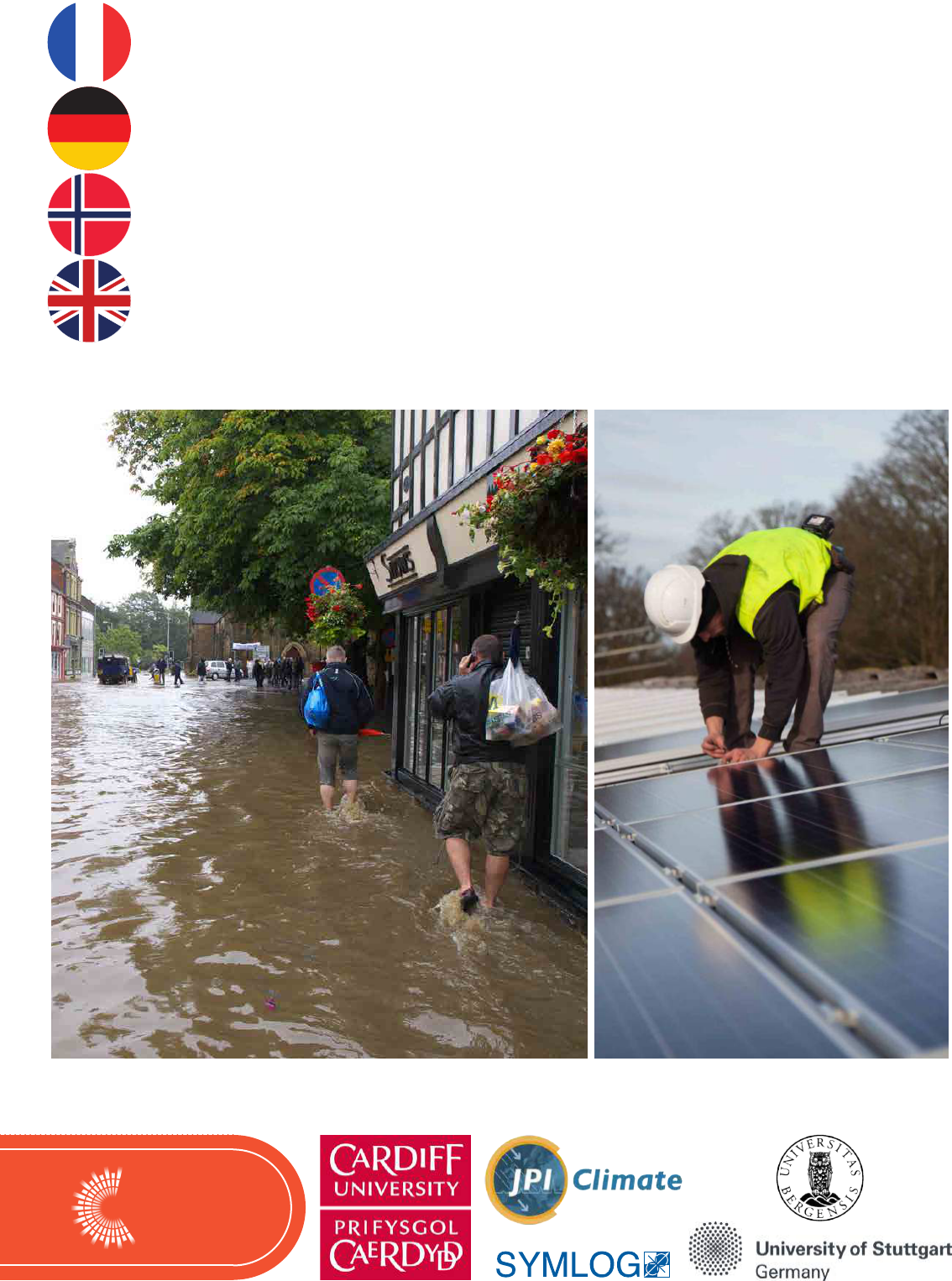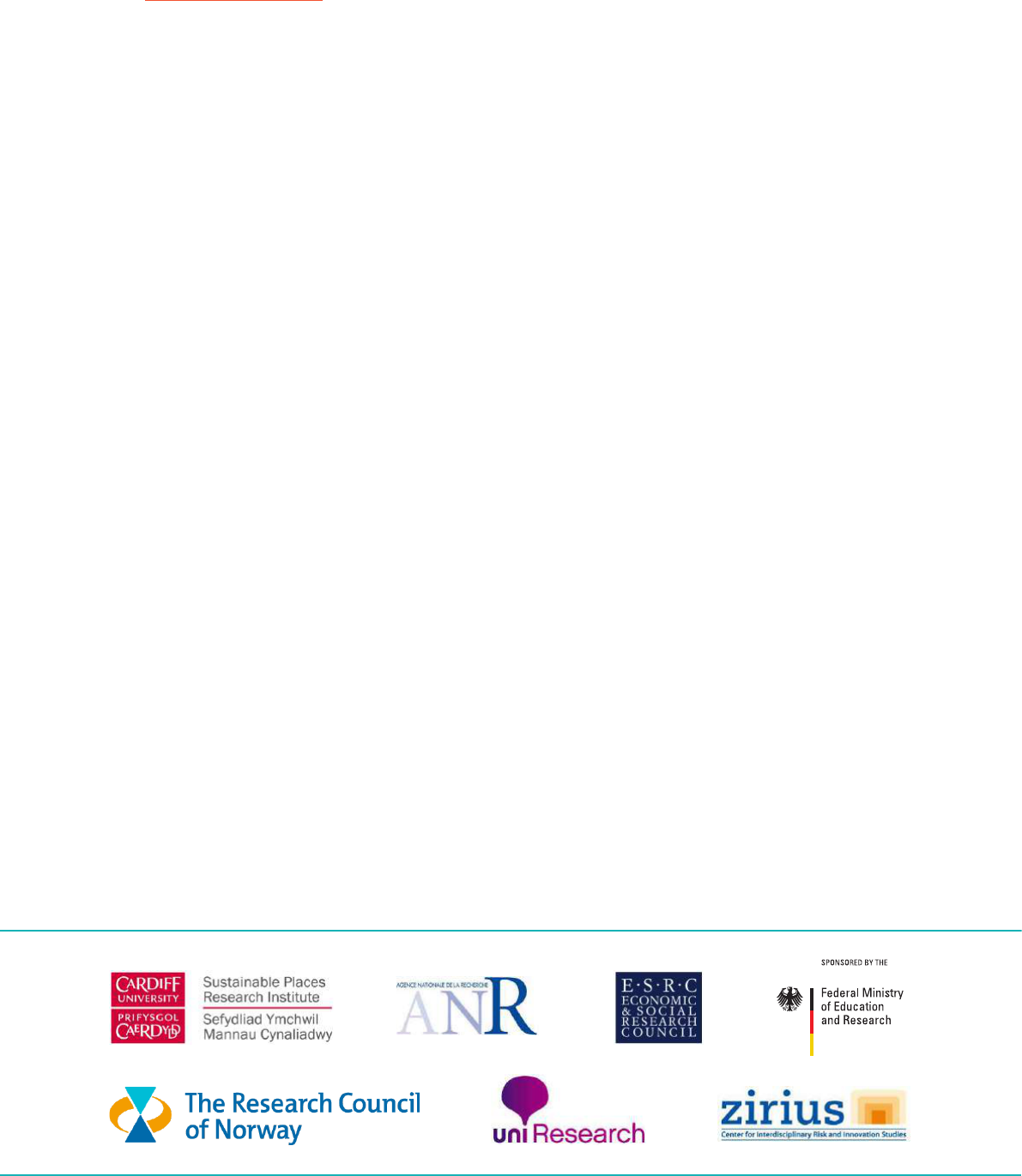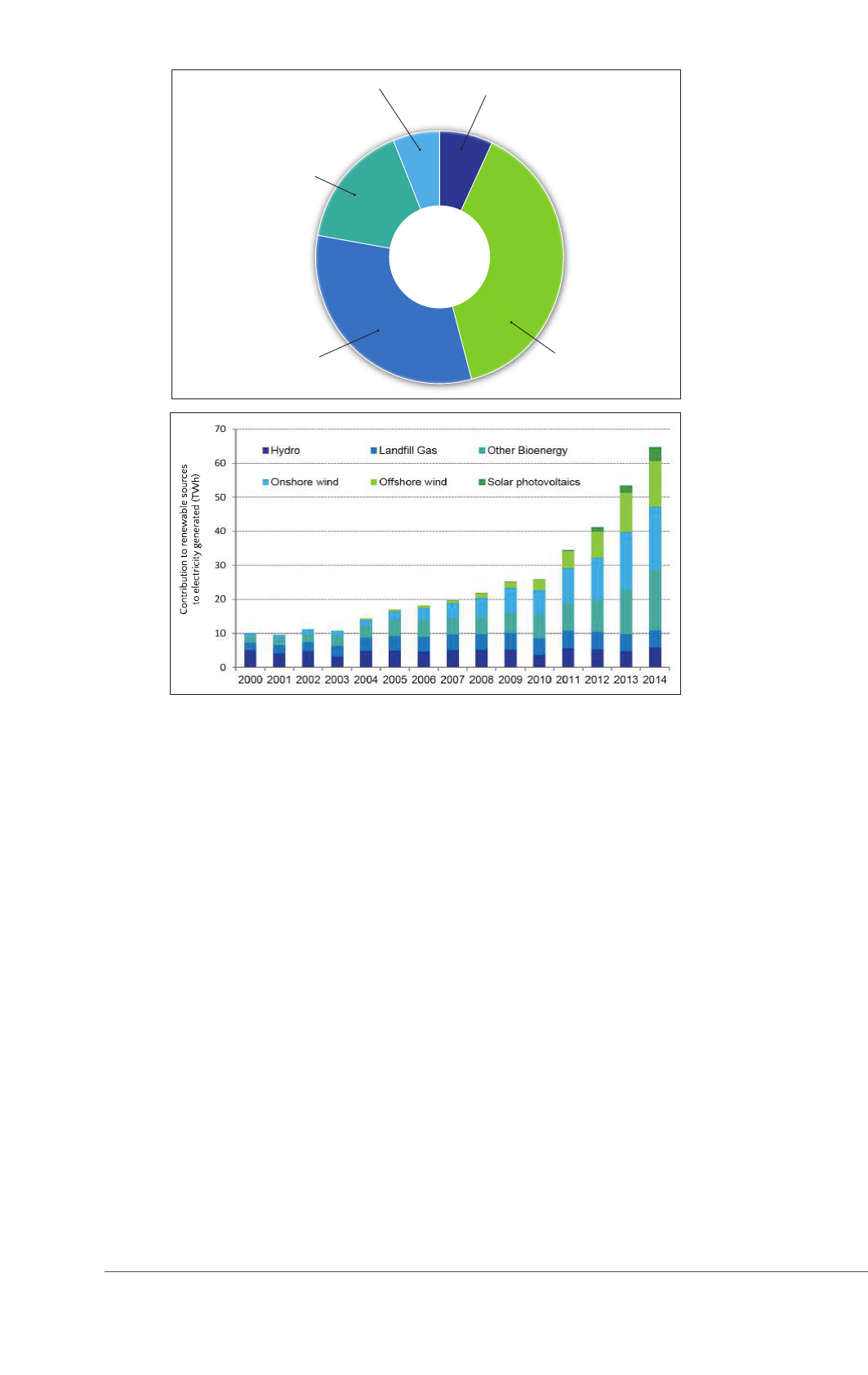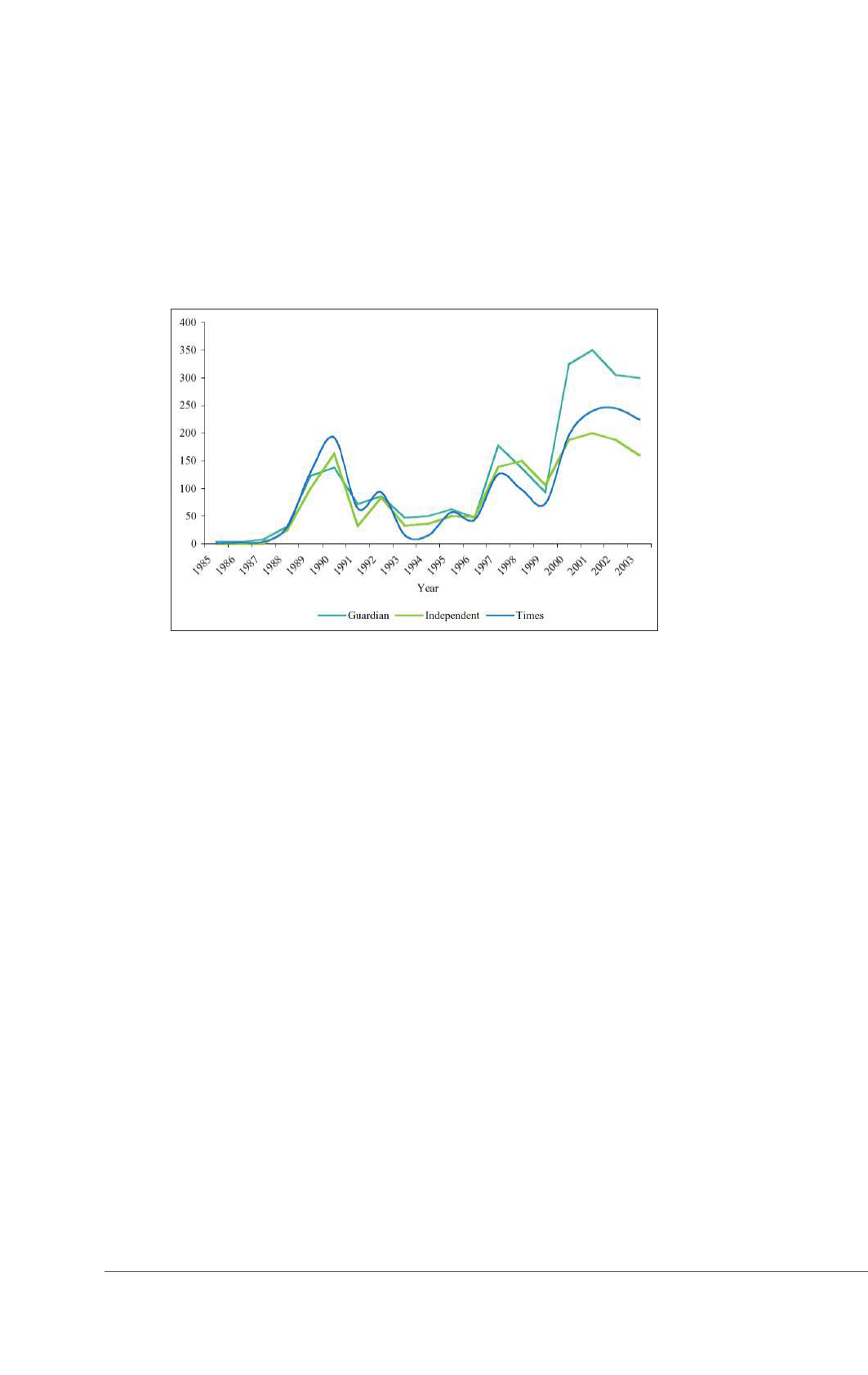
outreach
CLI MATE
formerly COIN
European Perceptions
of Climate Change (EPCC)
Socio-political profiles to inform a cross-national
survey in France, Germany, Norway and the UK
June 2016

About the EPCC project
The European Perceptions of Climate Change Project (EPCC) is coordinated by Cardiff
University and forms part of the Joint Project Initiative-Climate Change (JPI-Climate -
see www.jpi-climate.eu), a research programme uniting National Research Councils
across Europe. Inter-disciplinary teams from the UK, Germany, France and Norway are
individually funded to collaborate in the design and analysis of a major comparative survey
of climate and energy beliefs amongst the public in these 4 participating nations.
This research project has been supported through JPI Climate Programme and associated
grants from Cardiff University Sustainable Places Research Institute, School of Psychology
and the Economic & Social Research Council, ESRC (ES/M009505/1).
This research project has been co-funded by France’s Agence Nationale de la Recherche
under grant n° ANR-14-JCLI-0003.
This research project has been funded under the KLIMAFORSK programme of the
Norwegian Research Council (NFR; project number 244904).
This research project has been funded under the cooperation agreement between Statoil
and the University of Bergen (Akademiaavtale; project number 803589).
The research project has been funded by the German Federal Ministry of Education and
Research (funding code: 01UV1403).
Acknowledgements
Many thanks to the members of our International Stakeholder Advisory Panel:
Ewan Bennie, Department for Energy and Climate Change
Nick Molho, Aldersgate Group
Christian Teriete, Global Climate Change Alliance / European Climate Foundation
Caroline Lee, Organisation for Economic Co-operation and Development / International
Energy Agency
Tom Brookes, European Climate Foundation
Henri Boyé, Former Environment and Sustainable Development Council
Anders Nordeng, Thomson Reuters Point Carbon
Nils Tore Skogland, Friends of the Earth Norway
Karen Louise Nybø, Hordaland County Council
Sølve Sondbø, Hordaland County Council
Christopher Brandt, Climate Concept Foundation
Manfred Treber, Germanwatch

Project team
Authors
Cardiff University, UK (Coordinator)
Nick Pidgeon, Lead Investigator - PidgeonN@cardiff.ac.uk
Wouter Poortinga - PoortingaW@cardiff.ac.uk
Katharine Steentjes - Steentjes[email protected]
Climate Outreach, UK
Adam Corner - adam.corner@climateoutreach.org
Institut Symlog, France
Claire Mays - claire.mays@gmail.com
Marc Poumadère - [email protected]
Rokkan Centre for Social Studies, Norway
Endre Tvinnereim - Endre.Tvinner[email protected]
University of Bergen, Norway
Gisela Böhm - [email protected]
University of Stuttgart, Germany
Annika Arnold - [email protected]
Dirk Scheer - [email protected]
Marco Sonnberger - [email protected]
Editing & Production
Anna MacPhail, Project Coordinator, Climate Outreach - anna.macphail@climateoutreach.org
Olga Roberts, former Project Coordinator, Climate Outreach
Elise de Laigue, Designer, Explore Communications - elise@explorecommunications.ca
About Climate Outreach
Climate Outreach (formerly COIN) is a charity focused on building cross-societal
acceptance of the need to tackle climate change. We have over 10 years of experience
helping our partners to talk and think about climate change in ways that reect their
individual values, interests and ways of seeing the world. We work with a wide range
of partners including central, regional and local governments, charities, business, faith
organisations and youth groups.
The Old Music Hall, 106-108 Cowley Road, Oxford OX4 1JE, UK
+44 (0) 1865 403 334 @ClimateOutreach
[email protected] Climate Outreach
www.climateoutreach.org Climate Outreach
Cite as: Arnold, A., Böhm, G., Corner, A., Mays, C., Pidgeon, N., Poortinga, W., Poumadère, M., Scheer, D., Sonnberger, M.,
Steentjes, K., Tvinnereim, E. (2016). European Perceptions of Climate Change. Socio-political proles to inform a cross-
national survey in France, Germany, Norway and the UK. Oxford: Climate Outreach.
Cover photos by johndal and Kristian Buus.
JUNE 2016
in
f
@

Contents
Executive summary............................................................................................................................... 5
France .................................................................................................................................................................6
Germany ............................................................................................................................................................. 7
Norway ............................................................................................................................................................... 8
UK ........................................................................................................................................................................9
Key concepts to inform the survey design .........................................................................................10
Climate & energy in context .........................................................................................................................10
National energy policies ................................................................................................................................ 10
Media & other cultural inuences .................................................................................................................11
Climate impacts ................................................................................................................................................11
Personal engagement .....................................................................................................................................12
Climate scepticism & environmentalism ....................................................................................................12
Introduction: climate change and the European public ....................................................................13
France: A socio-political prole .......................................................................................................... 16
Historical, cultural and policy context.........................................................................................................16
Key actors in the French context ................................................................................................................ 20
Key climate and energy-related events in France ...................................................................................25
Anticipated consequences of climate change in France ........................................................................28
Media reporting in France .............................................................................................................................28
Germany: A socio-political prole ......................................................................................................31
Historical, cultural and policy context.........................................................................................................31
Key actors in the German context ............................................................................................................... 33
Key climate and energy-related events in Germany ...............................................................................36
Anticipated consequences of climate change in Germany ....................................................................38
Media reporting in Germany ........................................................................................................................39
Example for illustration: Coal extraction in Germany .............................................................................42
Norway: A socio-political prole ....................................................................................................... 43
Historical, cultural & policy context ...........................................................................................................43
Key actors in the Norwegian context .........................................................................................................45
Key climate and energy-related events in Norway .................................................................................49
Anticipated consequences of climate change in Norway ..................................................................... 50
Media reporting in Norway ...........................................................................................................................51
Norway and COP21 .........................................................................................................................................51
UK: A socio-political prole ............................................................................................................... 53
Historical, cultural & policy context ...........................................................................................................53
Key actors in the British context .................................................................................................................. 57
Key climate and energy-related events in the UK ...................................................................................59
Anticipated consequences of climate change in the UK .........................................................................61
Media reporting in the UK ..............................................................................................................................61
UK and COP21 .................................................................................................................................................66
References ........................................................................................................................................... 67

5
European Perceptions of Climate Change • Socio-political proles to inform a cross-national survey in France, Germany, Norway and the UK
Executive summary
‘European perceptions of climate change’ (EPCC) is a two-year project, with the central
aim of designing and conducting the rst ever theoretically grounded cross-national
survey of public perceptions of climate change and energy transition in Europe. EPCC is
a collaboration between academic teams in four participating nations (France, Germany,
Norway and the UK, led by Nick Pidgeon at Cardiff University) and Climate Outreach, a
UK-based think tank which specialises in climate change communication.
The purpose of this discussion paper is to provide a detailed overview of the socio-
political context in each of the four participating nations. A key feature of the EPCC survey
is that its design was directly informed by these national ‘proles’, as well as by an ongoing
process of stakeholder engagement with an international advisory panel. Following a
general introduction outlining the pan-European context, the paper presents four separate
national analyses, each organised into ve sub-sections:
y The historical, cultural & policy context in each nation;
y Key actors shaping public perceptions of energy and climate change in each nation;
y Key climate and energy-related events that have taken place so far;
y The anticipated consequences of climate change in each nation;
y Media reporting on energy and climate change.
Because the analyses are quite detailed, we also provide in the next four pages a very brief
summary of the key issues relating to each of the four nations in this Executive Summary,
and identify Key Concepts (arising from these analyses) which inform the survey design
(also highlighted throughout the document in blue boxes). In this way, we seek to make the
links between the different components of the project clear. These key aspects informed
the design of the EPCC questionnaire, alongside detailed study of the literature of previous
surveys, and our own stakeholder consultation process.

6
European Perceptions of Climate Change • Socio-political proles to inform a cross-national survey in France, Germany, Norway and the UK
France: summary of key issues
y France has low GHG emissions per capita relative to
other European and developed nations. This is largely
due to the fact that the electricity production is mainly
nuclear. Legislation voted in 2015 will reduce French
reliance on nuclear energy from an average of 75% of
the electricity mix to 50% by the year 2025. Moreover
there is a target to reduce total energy consumption by
50% by 2050.
y France hosted the COP21 meeting in Nov-Dec. 2015
and Conference president Laurent Fabius won high
esteem for successfully leading the parties to a strong
and historic agreement. After the record-breaking
signature of the Paris Agreement by 175 parties on Earth Day in April 2016, successor
president and Ecology Minister Ségolène Royal announced 12 decrees or decisions
advancing specic mitigation actions in France.
y The dense network of territorial government units is recognised and encouraged in
national governmental discourse as a major actor in climate change adaptation.
y NGOs and civil society organisations are increasingly represented in state consultative
bodies discussing measures to mitigate climate change.
y The French Academy of Sciences includes a very small fringe of scientists who deny
climate change which at times can gain a disproportionate presence in the media.
y France is a culturally and historically Catholic country. Pope Francis’ June 2015
environmental encyclical calling on all religions to take action on climate change was
taken note of in France.
y France is projected to experience more frequent and longer periods of heatwaves
(potentially fatal to at-risk populations – the elderly, infants, the chronically/gravely ill
etc.) and droughts.
The Scandola Nature Reserve
is located on the west coast of
the French island of Corsica,
within the Corsica Regional
Park. The park and reserve
were added to the UNESCO
World Heritage List in 1983.
Photo: orangebrompton

7
European Perceptions of Climate Change • Socio-political proles to inform a cross-national survey in France, Germany, Norway and the UK
Germany: summary of key issues
y The history of public engagement with energy and
climate change in Germany has been strongly shaped
by major public protests against nuclear energy. These
started in the 1970s and continued well into 2000s,
resulting in a nuclear phase-out before 2022.
y The level of environmental awareness is traditionally
high among German citizens. In 1983 the Green Party
entered the German Parliament for the rst time and
was part of the governing coalition between 1998 and
2005. In the 2014 survey on environmental awareness in
Germany, respondents ranked environmental protection
as fth among a list of the most important social issues
currently facing Germany.
y Climate scepticism is not considered a serious problem in Germany. A national survey
in 2014 reported that only 7% of respondents could be considered ‘trend’ or ‘attribution’
sceptics, only 8% as ‘consensus’ sceptics and only 5% as ‘impact’ sceptics.
y Politically, climate and environmental issues are closely related to the intended
transition of the energy system in Germany (‘Energiewende’). This transition aims at
meeting national energy demands by at least 60% of renewable energy by 2050.
However, brown and black coal are still important energy sources in Germany. The
coal extraction industry not only serves as an important employer in Germany but also
forms a part of regional identities.
y Climate change is a prominent issue in German news coverage, occurring frequently
as the main cover story in magazines and newspapers. In 1986, Der Spiegel – one of
the main news magazines in Germany – published an edition introducing the climate
catastrophe with a ctional cover picture showing the Cologne Cathedral being ooded.
y According to current models, the impacts of climate change will mostly be moderate
in Germany. The economy, especially agriculture in eastern Germany and those regions
that depend on winter tourism will be affected by rising temperatures.
The Jasmund National Park
is a nature reserve in the
Jasmund peninsula, in the
northeast of Rügen island in
Mecklenburg-Vorpommern,
Germany. It was added to the
UNESCO World Heritage List
in 2011 as an extension to the
Primeval Beech Forests of the
Carpathians and the Ancient
Beech Forests of Germany.
Photo: Pablo Necochea

8
European Perceptions of Climate Change • Socio-political proles to inform a cross-national survey in France, Germany, Norway and the UK
Norway: summary of key issues
y Oil and hydroelectric power play important roles in
Norwegian society, as key providers of employment and
energy. While the country’s GHG emissions are close to
the European average at about 11 tonnes CO
2
e/capita
per year, Norway’s emissions prole is unusual, with
essentially zero emissions from power production but high
emissions from oil and gas extraction in the North Sea.
y The economic importance of the fossil fuel and
hydropower sectors blends with social identity and
conceptions of nature to form powerful narratives
around how Norway found and exploited its offshore oil
and gas resources.
y National and international companies, the central government bureaucracy, business
and labour associations and NGOs seek to further their own interests in debates over
the future of fossil fuel exports versus renewable energy and climate protection in the
future. ‘Cognitive dissonance’ emerges because the country seeks a climate-friendly
image at home and abroad, while being unable to curb its domestic emissions and
maintaining fossil fuel exports at relatively high levels.
y Unlike countries such as the US and Australia, climate change is not considered
primarily as a left-right issue in Norway, and Norway does not have any signicant
climate sceptical news outlets.
y Norway’s most important mitigation policies are the EU emissions trading scheme,
strong support for electric vehicles and overseas aid to reduce tropical deforestation.
y Heavier rainfall, more frequent landslides and heavier oods are likely to result from
climate change as average annual temperatures are expected to increase by about
4.5ºC (range: 3.3 - 6.4ºC) and annual precipitation by about 18% (range: 7 - 23%).
Norway is set to experience less snow and glaciers will shrink or disappear.
The Geiranger Fjord is a fjord in
the Sunnmøre region of Møre
og Romsdal county, Norway. It
was listed as a UNESCO World
Heritage Site in 2005, jointly
with the Nærøyfjorden.
Photo: Whuups

9
European Perceptions of Climate Change • Socio-political proles to inform a cross-national survey in France, Germany, Norway and the UK
UK: summary of key issues
y The industrial revolution, the discovery of North Sea oil
and an ambivalent/unsettled relationship with nuclear
power are key issues in the historical background of the
UK in relation to energy.
y A broad cross-party consensus on climate change led
to a world-leading Climate Change Act (2008), and the
instalment of the Committee on Climate Change to track
the progress towards an 80% emission reduction by 2050.
y Media analysis has identied scepticism in the media to
be primarily an Anglophone phenomenon with sceptics
views given more presence in the US and UK media than
in other countries.
y The UK ‘political sector’ has a history of framing nuclear power as a solution to climate
change, while public perception research identies a consistent preference for
renewable energy among the UK public (Spence et al. 2010).
y The current conservative government announced the phase-out of subsidies for
onshore wind farms and solar systems, and continues to support the development of
shale gas, North Sea oil and gas, and nuclear power.
y In 2015 the government received criticism from UN scientists and business analysts for
‘sending mixed signals’ with regards to the support for low-carbon technologies and
solutions in the UK.
y Climate change is expected to increase the risk of severe ooding and hotter summers
in the UK, with potential opportunities (e.g. for the agricultural sector).
The Jurassic Coast covers 95
miles of stunning coastline
from East Devon to Dorset,
in Southern England. It was
added to the UNESCO World
Heritage List in 2001.
Photo: GaryW2008

10
European Perceptions of Climate Change • Socio-political proles to inform a cross-national survey in France, Germany, Norway and the UK
Key concepts to inform
the survey design
The purpose of completing these socio-political analyses was to provide – in conjunction
with the advice and guidance of the stakeholder panel – a robust and practically-grounded
evidence base with which to inform the design of the survey. By situating the design of
the EPCC survey in stakeholder views and an analysis of the socio-political context in
each participating nation, the project aims to go beyond simply documenting differences
between European publics on climate change, and say something about why these
differences are apparent. Throughout the document, key concepts which have, in addition
to theoretical considerations, informed the survey design are highlighted in blue boxes. In
this section we summarise them for ease of reference.
The EU’s central position in the global climate change policy debate may impact on
European publics in a number of ways. On the one hand, the (relatively) high prole
leadership provided by the EU at a global level may act as a cue for European citizens
to take climate change more seriously. But it is also possible that the centrality of
climate change to the EU could mean that the issue of climate change is conated
with the ‘European Project’ – and all the negative connotations that this has for some
European citizens.
The political attention given to the global economic recession, the serious impacts
it has had on European citizens’ lives, and the ongoing challenges that people face
in terms of employment and income are highly likely to detract from the relative
perceived importance of issues like climate change.
In response to the discussion around climate change migration sparked by the current
refugee crisis in the EU, our research could assess the perceived link between climate
change and migration and concern about ‘climate change victims’.
Climate & energy in context
The EPCC survey will be able to shed light on the relationship between political
ideology and views about energy and climate change in the four participating nations,
as well as differences in views emerging from a classical ‘environmentalist’ tradition of
thought, and more ‘technologically optimistic’ perspectives.
Climate scepticism is a largely Anglophone phenomenon (in terms of media coverage
and public perceptions), and is therefore likely to be higher in the UK than in other
participating nations. The concentration of climate sceptical views in the media may
also lead to a higher political polarisation than in the other countries.
Climate scepticism & environmentalism

11
European Perceptions of Climate Change • Socio-political proles to inform a cross-national survey in France, Germany, Norway and the UK
KEY CONCEPTSKEY CONCEPTS
Although the EPCC study cannot monitor media discourse and volume in detail, our
analysis of survey results will be attentive to this as a possible factor in any changes in
perceptions (within each nation, and whether these track trends in media coverage)
and between the four nations.
Perceptions of political inaction may increase the sense among some citizens that “the
impact of climate change was exaggerated by climate scientists as well as the media”
(Ryghaug et al., 2011, p. 790). This should be seen in connection with the fact that trust
in the state is much stronger in Norway than in many other countries.
A widespread feeling of national environmental identity (being associated with the
green landscape) might be able to explain attitudes towards renewable energy – we
will be able to explore whether the four countries dene their national identity in the
same way and how that affects their attitudes towards climate change policies.
Media & other cultural influences
There are likely to be differences in the national climate and energy ‘self-identity’ of
EU members who are ‘producers’ of energy and those who are primarily ‘consumers’
of it. There is an important question about whether these sorts of dynamics impact
on public perceptions of energy and climate change – and how comparisons with the
energy and climate policies of other EU states may inuence national perceptions.
The EPCC survey will be able to compare levels of support for fossil fuels between
the four participating countries, both now and into the future. There may be regional
differences within nations (e.g. in the UK, on perceptions of North Sea oil).
The decision to phase-out nuclear energy and the transition to an energy system
mainly based on renewables is one of the most important aspects of German
environmental policy, and the EPCC survey will be able to compare public views on
the components of the Energiewende with attitudes towards renewables in the other
participating nations.
There are likely to be important differences in perceptions of nuclear power, for
example in the way that the technology is ‘framed’ (as a ‘low-carbon technology’), and
in different national response to the Fukushima disaster.
National energy policies

12
European Perceptions of Climate Change • Socio-political proles to inform a cross-national survey in France, Germany, Norway and the UK
KEY CONCEPTSKEY CONCEPTS
The EPCC survey will be able to compare levels of perceived need for ‘personal’ or
‘domestic’ activity to limit the effects of climate change, and assess whether they differ
across the four participating nations.
Do per capita emissions relate to the four nations’ public perspectives on climate
change and energy use?
The EPCC survey will be able to compare emotional and affective reactions to climate
change and energy system change in the four participating nations.
Trust in the state is much stronger in Norway than in many other European countries.
The EPCC survey will be able to compare levels of trust in policy actors, and perceived
policy action/inaction.
The EPCC survey will include items that help explore the factors underlying this
tension, which may derive from a conict between classical environmentalist and
technologically optimistic strands of thought.
While levels of climate change scepticism have been low over the last few years the
presence of climate change sceptic views in the UK media landscape might lead the
public to underestimate how many people consider climate change in their daily lives.
Personal engagement
The EPCC survey can identify whether perceptions of the seriousness of climate
impacts in four participating nations differ, and whether these differences have any
relation to the actual projected impacts of climate change in each nation. Where are
there potential ‘opportunities’ from climate change for individual nations and will this
impact on public perceptions of climate risks?
People in areas more likely to be affected by climate impacts (and/or people who
indicate previous experience with climate change impacts) might perceive climate
change to be less of a ‘distant’ issue, which might lead to higher concern about climate
change and more willingness to engage in related behaviours (differences may emerge
between or within participating nations).
The UK public might be more positive about the national impacts of climate change
compared to people in (e.g.) France due to the potential opportunities for the UK.
Climate impacts

13
European Perceptions of Climate Change • Socio-political proles to inform a cross-national survey in France, Germany, Norway and the UK
In April 2016, 175 parties (174 countries plus the EU, which represents 28 countries) signed
up to the Paris Climate Agreement. The Agreement itself had been agreed at the summit
held in Paris at the end of 2015. Whilst the Paris summit did receive media attention
across Europe, it’s important to note the quantity of the coverage wasn’t as high as that
of the Copenhagen conference in 2009. The quality of the reporting, however, was much
more positive, and negotiators were able to get across a good news message about the
outcomes of the summit.
1
This sense of optimism has been carried through to the signing of
the Paris Climate Agreement.
For the EU, the climate negotiations in Paris were a diplomatic success, aligning global
ambition on climate policy with the EU’s longstanding call to limit global warming to an
average of 2 degrees celsius.
2
As part of its commitment to the 2°C limit the EU has set a
climate target of reducing emissions by at least 40% by 2030. However, up to now that
target has only been a statement of intention. The EU has held off implementing legislation
in the run up to the Paris summit because the steps needed to meet the targets are deeply
contested by some member states. Subsequent to the signing of the Paris agreement the
EU now has to push forward with agreeing the required policies needed to deliver these
cuts. This potentially divisive process will be taking place against a backdrop of other
threats to EU unity. In addition, the challenge of implementing this climate legislation is
exacerbated by the introduction at the Paris summit of a possible 1.5°C target for warming,
which may require the EU to either bring forward the date by which the cuts will be
achieved or strengthen the target itself.
3
In the context of this crucial moment for European climate policy, the EPCC project
addressed a signicant knowledge gap with regard to European public engagement with
climate change. While there have been national polls of EU member states and occasional
cross-European surveys of public opinion (most notably the ‘Eurobarometer’ series which
has sometimes included items relating to climate change), there is very little evidence on
how citizens in different European nations differ on engagement with climate change.
By grounding the design of the EPCC survey in stakeholder views and an analysis of
the socio-political context in each participating nation, the project aims to go beyond
simply documenting differences between European publics on climate change, and say
something about why these differences are apparent. The focus of the current discussion
1 Pashley, A. (2016). Why did Paris climate summit get less press coverage than Copenhagen? Climate Home. Online: http://www.
climatechangenews.com/2016/03/07/why-did-paris-climate-summit-get-less-press-coverage-than-copenhagen/
2 Geden, O. and Droge, S. (2016). After the Paris Agreement - New Challenges for the EU’s Leadership in Climate Policy. German
institute for International and Security Affairs. Online: http://www.isn.ethz.ch/Digital-Library/Articles/Detail/?id=196630.
3 ibid
Introduction: climate change
and the European public

14
European Perceptions of Climate Change • Socio-political proles to inform a cross-national survey in France, Germany, Norway and the UK
INTRODUCTIONINTRODUCTION
paper is on the ways in which key events, inuential actors, media and the wider cultural/
historical and policy context in the four participating nations may impact on public
engagement with climate change.
The European Union (EU) itself, and notably the European Commission, is an important and
unusual actor at a pan-European level in terms of setting the agenda on climate change. As
a longstanding, well-established and relatively stable regional grouping, it has historically
been a leading voice advocating for policies to mitigate and adapt to climate change
(Rayner & Jordan, 2013; Tvinnereim, 2013). In rhetoric and in policy ambition, the EU has
tended to position itself as a world leader on climate change. The EU has committed to
spending at least 20% of its €960 billion budget for the 2014-2020 period on climate
change-related policies. And even if the ambitions of EU directives have not always
resulted in proven policy efcacy or inuence on other key global actors (Jordan et al,
2010), it has been argued that “the EU can be looked upon as a rather benign ‘critical case’:
if [it] cannot develop effective climate policies, then the implications for the globe are grim”
(Wettestad, 2000).
However, while there are clearly important inuences which might be expected to operate
at a pan-European level, every European nation has a different social, political, historical
and cultural context which shapes public engagement with climate change.
There are likely to be differences in the national climate and energy ‘self-identity’ of
EU members who are ‘producers’ of energy and those who are primarily ‘consumers’
of it. There is an important question about whether these sorts of dynamics impact
on public perceptions of energy and climate change – and how comparisons with the
energy and climate policies of other EU states may inuence national perceptions.
The EU’s central position in the global climate change policy debate may also impact
on European publics in a number of ways. On the one hand, the (relatively) high
prole leadership provided by the EU at a global level may act as a cue for European
citizens to take climate change more seriously. But it is also possible that the centrality
of climate change to the EU could mean that the issue of climate change is conated
with the ‘European Project’ – and all the negative connotations that this has for some
European citizens.
While it is not within the scope of this paper to document in detail the dozens of trends
and political, economic or cultural developments that have shaped the EU and its member
states, it is possible to point to some ‘meta-trends’ that have characterised and dened
Europe (and by extension the wider world) over the past decade.
The nancial crash of 2008 – triggered by lending practices in US banks, but with its roots
in debt-driven property market bubbles in many Western nations – quickly enveloped
most of Europe in an economic recession that has not yet passed. While some nations
responded unilaterally to worsening economic conditions by spending large amounts of
public money on propping up nancial institutions, and injected new stocks of money
into the economy through ‘quantitative easing’, the EU as a whole advocated a policy of
‘austerity’ (substantial reductions in government expenditure on public services), which
was mirrored in many of its member states. Nations such as Spain, Ireland and Greece
have experienced huge increases in unemployment and a serious deterioration in the
living standards and livelihoods of many millions of people.

15
European Perceptions of Climate Change • Socio-political proles to inform a cross-national survey in France, Germany, Norway and the UK
INTRODUCTIONINTRODUCTION
The implementation of the EU’s austerity measures has caused signicant disagreements
between member states – in particular Germany and Greece – and played a role in a
process of political fragmentation in some nations, with new political parties emerging on
both the left and the right of the political spectrum. The left-leaning parties (e.g. Podemos
in Spain, Syriza in Greece) have rejected the logic of austerity and called for a return to
higher public spending and employment. The right-leaning parties (e.g. UKIP in the UK, the
Front National in France) have tended to focus on the role of immigration and argued for
tighter controls to protect jobs and services for existing nationals.
These signicant and profound changes to the relative stability enjoyed within most EU
member states previously provide the backdrop against which public attitudes to climate
change, energy, or any other subject must be considered.
The political attention given to the global economic recession, the serious impacts it
has had on European citizens’ lives, and the ongoing challenges that people face in
terms of employment and income are highly likely to detract from the relative perceived
importance of issues like climate change.
Assuming people have a “nite pool of worry” (Weber, 2010), issues which do not
manifest themselves in an immediate and tangible way are likely to be crowded out by
more pressing concerns (Scruggs & Benegal, 2012; Shum, 2012). And there is evidence that
the perceived importance of climate change and environmental issues can drop (even if
temporarily) in response to major economic and societal events (e.g. the recession sparked
in 2008, or immigration ows) both in individual European nations (UK – DECC, 2015) and
across the continent as a whole (Eurobarometer, 2013).
This is the pan-European context against which national attitudes to climate change should
be considered. The paper now discusses in detail the national socio-political contexts in
the four participating nations in the EPCC project.

16
European Perceptions of Climate Change • Socio-political proles to inform a cross-national survey in France, Germany, Norway and the UK
Historical, cultural and policy context
≈ The nuclear technocracy
France has the largest share of nuclear electric production in both Europe and the world,
and the second largest number of reactors after the United States. In parallel with military
development in the aftermath of World War II, the exploitation of France’s uranium
reserves in a French-designed electronuclear programme, served a denite goal of
increasing national prestige and energy independence. The 1973-74 worldwide oil crisis
was a springboard for massive expansion of this energy option. France’s national utility,
Electricité de France, sometimes called ‘a state within the state’, grew and prospered; and
historically its nuclear production capacity was generally over demand levels, even with
export schemes. Nuclear power still dominates primary energy production in France and
contributes massively to France’s 50% plus rate of energy independence
4
(CGDD, 2015)
as well as the cheapest electricity in Europe.
5
However, following a national deliberative
exercise, the July 2015 law on ‘Energy Transition for Green Growth’ will reduce the nuclear
share from an average 75% to 50% by the year 2025. In Spring 2016, there was discussion
in the media of the large nancial risks attached to Electricité de France’s Hinkley Point
nuclear new build project in the UK.
The top-down, centralised governance visible in the nuclear sector is very characteristic
of France, as is the idealisation of the scientic elite. Various commentators point to
these traits – exemplied in the nuclear ‘technocracy’ – as shaping public perceptions of
climate change and possible ‘solutions’ to it.
Teräväinen et al. (2011) analysed nuclear discourse in regard to climate change. The major
strategies used by nuclear power advocates in France are necessitation (the authors
quote then-President Sarkozy as saying in 2010 “There is not a single serious person who
could think that we can full our objectives by using only renewable energy sources”) and
naturalisation (as when nuclear power production is described as self-evidently carbon-
free or low-carbon, safe and affordable). The main strategy used by opponents to nuclear
power in France has been scientication, “resorting to scientic evidence and expert
knowledge to refute the argument that nuclear power would help to combat climate
change”, and borrowing government statistics to support claims.
4 A measure of self-sufciency. Dened by the national institute of statistics INSEE.fr as: the ratio between national production of
primary energies (coal, oil, natural gas, nuclear, hydro, renewable energy) and the consumption of primary energy, in a given year.
5 14.12 C€/kWh in 2013, according to Electricity of France. Online: https://www.lenergieenquestions.fr/wp-content/uploads/2013/05/
électricité-comparateur-pays.pdf
France:
A socio-political profile

17
European Perceptions of Climate Change • Socio-political proles to inform a cross-national survey in France, Germany, Norway and the UK
FRANCEFRANCE
≈ Visibility of climate change
The current French President, François Hollande, proposed France as host of the annual
UN climate change summit in Nov-Dec. 2015. This 21st Conference of Parties to the UN
Framework Convention on Climate Change (COP21) was presided by Laurent Fabius, at the
time Minister of Foreign Affairs, with the announced aim of reaching a binding agreement
to limit global warming to 2°C beyond pre-industrial levels. In the lead-up to the meeting,
much Government communication revolved around the need for France to be exemplary
in its environmental performance (the COP21 village severely limited CO
2
emissions
resource consumption) as well as to provide strong leadership to ensure the protection of
the world’s future citizens. Laurent Fabius won high esteem from the assembled delegates,
leading the 195 parties to forge and adopt an agreement called “fair, sustainable, dynamic,
balanced and legally binding”, and “holding the increase in average temperature to well
below 2°C and pursuing efforts to limit this increase to 1.5°C, which would signicantly
reduce the risks and impacts of climate change”.
6
In April 2016, 177 parties signed the
agreement at the United Nations in New York.
7
In 2015-16 many governmental actions included specic references to climate change. For
example, the government-nanced voluntary ‘civic service’ employment programme for
young people (16-25 year olds) incorporated a new topic: ‘Energy transition, climate and
biodiversity’. Climate change is presented as involving every sector of economic life (e.g.
agriculture - for environmental awareness and better use of resources) and all citizens (e.g.
each household will be equipped with a smart electric meter to save energy).
Climate change in France was historically framed as one environmental and ecological
issue among many in the discussion of sustainable development. The term ‘climatic
warming’ (réchauffement climatique) was/is used. Scientists prefer this term putting the
focus on temperature rise, whereas political actors like Laurent Fabius tend to use the term
‘climate disruption’ (dérèglement climatique), placing the accent on the consequences of
global warming (Jouzel, in CNTE, 2015).
Ministerial structures to deal with climate change emerged at least as early as 1992.
In 2005 an Environmental Charter was incorporated into France’s Constitution and
focused attention on the precautionary principle (PP). Although the PP discussion tended
to focus predominantly on present-day public health and safety issues (and scandals),
consequences of climatic change were identied among ‘grave and irreversible’ effects to
be avoided. The growing discussion on the reduction of greenhouse gases has probably
been framed by European targets (cf. the 2008 Climate and Energy Package negotiations;
contrary to most other European countries, France had a limited scope for further
emissions reduction in the power generation sector given her already dominant share of
CO
2
-free power generation, mainly from nuclear; requests by both Chirac and Sarkozy to
consider nuclear power as a renewable energy source or at least a ‘carbon-poor’ source
were rejected by the EC).
6 http://www.cop21.gouv.fr/en/the-french-cop21-presidency-has-presented-a-nal-draft-agreement/
7 http://www.cop21.gouv.fr/en/a-record-over-160-countries-expected-to-sign-the-paris-agreement-in-new-york-on-22-april-2016/

18
European Perceptions of Climate Change • Socio-political proles to inform a cross-national survey in France, Germany, Norway and the UK
FRANCEFRANCE
In France, awareness of climate change has historically been high, but fewer people than
the European average believe that renewable technologies will be widespread by 2050
(Eurobarometer 2011, 2014). While local or regional governments are said to complain
about ‘immature technologies’, the major obstacles to climate adaptation and mitigation
in France’s various regions today were described by one observer to be “administrative
straitjackets, budgetary arbitrage, inability to work as teams, and resistance to change”
(CESE 2015).
≈ Energy production and consumption
France’s energy needs decreased sharply in the hot year of 2014. Primary energy
consumption (adjusted for climate variations) pursued a downward trend seen to have
started in 2005. Final energy consumption reached its lowest level since 1996. Much of the
2014 decrease can be ascribed to the residential sector’s lessened need for winter heating.
Conversely, there was a slight increase for transport, France’s foremost sector of energy
consumption (CGDD, 2015).
Primary energy production in France for 2014 was composed of 87% electricity, 12%
thermal (renewable fuelwood and recovered waste), 1% oil, and less than 1% each
for natural gas and coal. Within generated electricity, in 2014 nuclear was the source
of 94% whereas hydro, wind and solar power together provided a total of 6%. The
use of renewable fuelwood and hydro were both somewhat lower than usual due to
weather conditions (CGDD, 2015). The 2014 nal consumed energy mix in France was by
descending order: rened oil products (45%); electricity (22%); gas (20%); renewables
and recovered waste fuels (10%); coal (3%). According to provisional calculations, CO
2
emissions related to combustion for energy dropped by 9.4% in 2014 in real terms.
Emissions adjusted for climate variations are clearly falling: they have decreased by 2.4%
per year on average since 2007; their 2014 level was 15.6% lower than that of 1990 (CGDD,
2015).
France is already one of the European countries with lower emissions per unit GDP and
one of the developed countries with lower emissions per capita (7.51 tonnes CO
2
e/capita
in 2012, compared to 9.15 in the UK and 11.47 in the UK, and below the EU-28 average of
8.98 tonnes/capita
8
). This is largely due to the fact that the electricity production is mainly
nuclear.
One interesting question which the EPCC survey will be able to address is whether per
capita emissions relate to the four nations’ public perspectives on climate change and
energy use.
The 2013 update of France’s national climate change adaptation plan (‘PNACC 2011-2015’)
reinforced measures to reduce greenhouse gas emissions, in particular through improved
energy efciency. Actual implementation was favourably assessed at midterm: 92% of
the planned actions had started; 60% of the needed budget had been engaged (i.e. more
than €100m) in spite of a difcult budgetary context; 60% of actions were progressing
according to plan (CESE, 2014).
8 Eurostat table t2020_rd300

19
European Perceptions of Climate Change • Socio-political proles to inform a cross-national survey in France, Germany, Norway and the UK
FRANCEFRANCE
≈ The Energy Transition law
The programmatic law on ‘Energy Transition for Green Growth’ was adopted on 22 July
2015 after some 3 years of preparation under 4 different ecology ministers, and signicant
debate in France’s two houses of parliament. The law was identied as a agship
endeavour of the Hollande presidency. It is presented as a way for France to ght climatic
impacts, improve adaptation, and provide an example globally. Climate change adaptation
is presented as a growth opportunity (120,000 jobs are expected in the next 5 years to
develop renewable energies). The law legalises the ambitious targets already announced in
the National Climate Plan in 2013:
y 40% reduction in greenhouse gas emissions by 2030 (compared to 1990 levels);
y 30% reduction in fossil fuel consumption by 2030 (compared to 2012);
y Diversication of electricity production sources to arrive at a 50% nuclear mix by 2025;
y Renewable energies to rise to 32% of nal consumption and 40% of production by 2030;
y 50% reduction in nal energy consumption by 2050 (compared to 2012).
Amongst the measures with a potentially signicant impact on public experience are: state
aids to foster building insulation; clean transport and a circular economy; and support for
better air quality, including trafc restricted zones in cities.
The law was heralded as going far beyond the ‘lowest common denominator’ identied
by the European Council in 2014, and perceived as a good signal in the lead-up to COP21.
However, ecologists criticised the absence of a calendar for phase-in. Discussion on
how to achieve the targeted energy mix was not started until more than six months
after the formal adoption of the law. In parallel to the signature by 177 parties of the
COP21 Paris Agreement in April 2016, Ecology Minister Ségolène Royal issued decrees of
implementation or news of progress on a dozen fronts. These include a call for tender to
develop small-scale, localised hydroelectric generators; decrees on energy performance
requirements for new build and revision of energy standards for existing building stock to
become the most demanding in Europe; etc. Prime Minister Manuel Valls also spoke out on
the need to reform transport policy in harmony with the COP21 agreement.

20
European Perceptions of Climate Change • Socio-political proles to inform a cross-national survey in France, Germany, Norway and the UK
FRANCEFRANCE
Key actors in the French context
≈ Central government
COP21, hosted by France in Nov-Dec 2015, was successfully presided by Laurent Fabius,
Minister of Foreign Affairs (he has since left those posts to preside the Constitutional
Council). The minister was very active in the lead-up to COP21, emphasizing the goal of
facilitating a strong consensual agreement to limit global warming to 2°C, and engaging in
many international discussions.
Climate change and energy issues are dealt with in France principally by the Ministry of
Ecology, Sustainable Development, and Energy (MEDDE). Minister Ségolène Royal has
taken over the presidency of COP21. Within MEDDE, the General Directorate for Energy
and Climate (DGEC) is tasked with inter-ministerial coordination of policy to ght against
climate change, and also to ensure energy supply security at ‘best price conditions’ in an
open market. The National Observatory on Climate Change Effects (ONERC) prepared the
2006 National Climate Adaptation Strategy and the 2011 Adaptation Plan (PNACC) after
a national consultation in 2010. The 2013 PNACC update introduced a methodology to
dene the level of acceptable risk from climate hazards. ONERC acts as the ‘focal point’
coordinating France’s interaction with the IPCC.
Other ministries involved include the Interior, Infrastructure, Research, Agriculture, and
Overseas Territorial Development, etc.
Numerous national agencies give climate change issues a central place in their work
programme, such as ADEME (Energy efciency agency) and BRGM (Geological survey),
amongst others. All promoted COP21 as a signicant rendezvous in which France had
an important responsibility to broker a political solution to climate change. In the Prime
Minister’s ofce, the Centre for Strategic Analysis (now France Stratégie) inquired into
public perceptions of the threat posed by climate change and levels of climate scepticism
(Baecher et al., 2012; CAS, 2012), viewed as a determinants of the negotiating positions
taken by the Parties.
≈ The advisory system
The importance attached by the French state to ecology and sustainable development
issues is evidenced by the multiplication of highly specialised (and often overlapping)
public advisory bodies and agencies from the mid-1990s onward.
The Economic, Social and Environmental Council (CESE) calls itself the ‘Third Chamber’ of
France in light of its pluralistic and representative character. It counsels Government and the
two houses of parliament on the formulation of public policy. Climate change and energy
transition are strong themes for the CESE. In the lead-up to COP21 the CNTE is preparing
statements and reports, including one analyzing the effects of France’s past 20 years of
climate policy, and another focused on negotiation in view of brokering a Paris climate
agreement. A special emanation, called National Council on Energy Transition (and now
Ecological Transition; CNTE) includes representation from parliament, regional government,
trade unions (both labour and management), NGOs (environment, consumer rights, youth),
chambers of commerce, etc. Starting in 2013, CNTE engaged debate and consultation
events across France to inform and prepare the 2015 programmatic energy law.

21
European Perceptions of Climate Change • Socio-political proles to inform a cross-national survey in France, Germany, Norway and the UK
FRANCEFRANCE
The General Commissariat for the Environment and Sustainable Development (CGEDD)
is tasked with advising Government on issues affecting the environment and climate
change (including construction, transport, urbanisation, use of oceans, etc.). It inspects
the efciency of government strategies and services in these domains and examines
Environmental Impact Assessments for infrastructure plans, programmes and projects.
The Parliamentary Ofce of Assessment of Scientic and Technological Choices (OPECST)
advises the two chambers of the legislature. Studies and hearings are led by members
of parliament with the support of a permanent secretariat and a committee of 15 leading
scientists.
The French Academy of Science is a key advisory body, and is “the only academy
of sciences in the world in which the debate over human responsibility in climatic
disturbance is not yet closed. It is very sad and very grave” (corresponding member and
climatologist E. Guilyardi, in Foucart, 2015). Among its 263 members this historic chamber
contains a small number of active climate sceptics, including geo-chemist Claude Allègre,
a bombastic former minister and author of widely-diffused material on climate change
denial, and geo-magneticist Vincent Courtillot, criticised for repeatedly presenting data
already refuted by peer-reviewed publications. In May 2015, an Academy working group
suspended discussion of a pre-COP21 statement, due to objections over the rule allowing
a minority opinion to be annexed to the majority statement. “It would come down to
publishing a statement that the world is round, accompanied by another stating the
world is at”, said a former Academy president (cf. Foucart, 2015). A new plenary climate
discussion led to the November 2015 publication of a statement conrming the 2010
Academy report viewing anthropogenic climate warming as ‘unambiguous’, recognizing
progress in reduction of uncertainties, and calling for resolute R&D and industrial
innovation to transform the energy system (Académie des Sciences, 2015).
≈ Research institutes
Institut Pierre-Simon Laplace (IPSL) is France’s primary climate research organisation,
recognised among the major world climate science institutions. It is directed by
climatologist and IPCC member Hervé Le Treut, and previously by Jean Jouzel (vice-
president of the IPCC). IPSL is composed of 1400 members including professionals and
students. The CNRS (National centre for scientic research) is the network of university-
based laboratories and research groups. In August 2015, 10% of public information articles
searchable on CNRS’s plain-language website Le Journal contained the word ‘climate’
(43 out of 431 articles). Other pertinent national research institutes are Météo France
(meteorology), IRD (development), and INRA (agronomy). ONERC, mentioned above, is the
focal point coordinating all these institutes’ interaction with the IPCC.
≈ Multi-level governance
France has a dense top-down territorial administrative network including vast
responsibilities in risk governance. This state administration is superimposed upon the
elected government structures (regions, departments, and municipalities large and small).
Most, if not all, administrative and government units include some work programme or
discourse on climate change. Particularly in the run-up to COP21, they are making efforts
to raise awareness and consult the public. The Ecology Minister frequently claims that

22
European Perceptions of Climate Change • Socio-political proles to inform a cross-national survey in France, Germany, Norway and the UK
FRANCEFRANCE
France cannot meet the climate challenge without the local administrations and their
climate mitigation measures. The MEDDE website hosts ‘Wiklimat’,
9
a climate adaptation
knowledge-sharing platform open to all types of public and private actors.
≈ NGOs
Since the 1990s French decision-making has increasingly incorporated stakeholder
representation in advisory bodies and consultations. In particular, two environmental laws
since 2007 have been developed and negotiated through a process known as ‘Grenelle
de l’Environnement’. Themes of debate included inter alia: climate change and energy,
biodiversity and natural resources, environmental health, green development employment
and competitiveness. Stand-out NGOs in France include Greenpeace, WWF, FoE, CARE,
Réseau Action Climat (RAC, a public knowledge network), France Nature Environment,
Fondation Nicolas Hulot (the popular ecologist and action-reporter is also a special COP21
advisor to French President Holland), and other ecological, faith-based or justice-oriented
development organisations.
‘Coalition Climate 21’ is a diversied forum of 75 NGOs and unions (grouping a total of 135
NGOs internationally). It provides a forum where policy differences amongst the different
member organisations can be discussed so as to “contribute to forming a balance of
power favourable to ambitious and fair climate action, and the transformation of all related
public policy”.
10
In April 2015, Prime Minister Manuel Valls recognised their action to inform
and mobilise civil society for a political accord at COP21. The ‘grand national cause’ label
attributed by the PM gave the coalition free airtime on national television and radio.
In April 2016, the television producer and militant ecologist Nicolas Hulot, head of think
tank ‘Foundation for Nature and Man’, emerged in a survey as the most popular political
gure in France.
11
≈ Other actors
Pope Francis’ June 2015 environmental encyclical, partly attributing climate change to
human activity and fossil fuels and calling all religions to take action, was noticed in
the French context. In July 2015, President Hollande received representatives of the
Conference of Religious Leaders of France (CRCF) covering the spectrum of monotheist
and other religions. They advocate climate justice and call for a binding agreement
on climate policy, supporting the 2°C target for limiting global warming. “It is rst and
foremost our relationship with nature, and with God’s gift of creation, that is at stake”.
12
9 http://wiklimat.developpement-durable.gouv.fr/index.php/Wiklimat:Accueil
10 http://coalitionclimat21.org/en
11 http://www.lesechos.fr/politique-societe/politique/021878186464-nicolas-hulot-double-alain-juppe-dans-les-sondages-1217478.php
12 https://www.oikoumene.org/en/press-centre/news/religious-leaders-meet-french-president-to-advocate-for-climate-justice

23
European Perceptions of Climate Change • Socio-political proles to inform a cross-national survey in France, Germany, Norway and the UK
FRANCEFRANCE
≈ Political party positions on energy transition and climate change
In 2009, 78% of French voters stated that the candidates’ environmental platform
inuences their vote (IFOP, in Baecher et al., 2012). Comments below on political party
positions are based on a search of their websites in August 2015 and again in April 2016.
In a representative national survey, ADEME (2014) categorised persons as ‘convinced,
sceptical or hesitant’ about the reality of anthropogenic climate change. Correlations with
declared political afliation or sympathy (with 6 major parties) were calculated. While
signicance was not assessed, sympathisers of the right-wing parties showed the highest
proportion of scepticism in their survey replies. The percentage distributions for four major
parties are reported below. (For comparison, respondents declaring no political afliation
were categorised as 42% ‘convinced’, 11% ‘sceptical’, and 46% ‘hesitant’).
y Socialist party
13
France is governed today by a socialist majority. The new Energy Transition for Green
Growth law, showcased by the Socialist Party as a direct response to the ‘climate threat’
or ‘climate challenge’, is an example of its ‘doctrine of eco-socialism or social ecology’.
Like the government, the Socialist Party highlights energy transition as a great growth
opportunity and a source of hope and optimism. In the lead-up to COP21, the Party
website also laid typical stress on national government’s willingness to involve the local
level and youth. France was urged to show ‘exemplary’ climate behaviour and facilitate
a universal and binding agreement that will ‘maintain global temperature under 2°C [sic]’.
‘There is not an instant to lose, it’s urgent and it’s the responsibility of this generation to
prepare a different world for the coming generation(s).’ France’s role in COP21 was given
a historic, revolutionary dimension: ‘After establishing human rights, we will establish the
rights of Humanity, that is, the right for Earth’s inhabitants to live in a world where the
future is not compromised by the irresponsibility of the present’. In April 2016, the site
focussed primarily on electoral topics but two of three educational video segments on the
homepage presented ‘ecological taxes’ and ‘circular economy’.
ADEME (2014) found that Socialist party sympathisers could be categorised as 51%
‘convinced’ of the reality of climate change, 9% ‘sceptical’, or 39% ‘hesitant’.
y The Republicans
14
The website of the newly named right-wing party centred around former president Nicolas
Sarkozy, and his criticism of the current Socialist government, was searched using the
keywords ‘ecology’, ‘environment’, or ‘climate’. No results were returned.
ADEME (2014) found sympathisers with the UMP (former name of the party) to be 39%
‘convinced’ of climate change, 18% ‘sceptical’, and 43% ‘hesitant’.
13 http://www.parti-socialiste.fr
14 http://www.republicains.fr

24
European Perceptions of Climate Change • Socio-political proles to inform a cross-national survey in France, Germany, Norway and the UK
FRANCEFRANCE
y National Front
15
The far-right nationalist party expresses a populist view on several current climate change
measures. The ‘chaotic and irresponsible’ project, under Sarkozy and then Hollande, of an
eco tax on truck transport is described on the website as a ‘hard blow’ for French truckers
already subjected to ‘intolerable’ disloyal competition from East Europeans. Two FN
parliamentarians published a communiqué on the website stating that they voted against
the Energy Transition for Green Growth law. They recognise climate change affects: ‘health
and climate risks, scarcity of natural resources are growing realities’, but they denounce
the ‘coercive and limiting Socialist ecology’ poised ready to destroy the nuclear sector,
the pride of France. ‘Although ecological issues are global, a pragmatic national response,
respectful of economic and budgetary balances, is needed for a viable and sustainable
ecology.’ In April 2016, ‘ecology’ appeared at the bottom of a list of site keywords, and
returned news items all of which used environmental themes strictly to question the safety
of the French populace and the probity of political leaders outside the Front.
ADEME (2014) found National Front sympathisers to be 33% ‘convinced’ of climate change,
18% ‘sceptical’, and 49% ‘hesitant’.
y Europe Ecologie les Verts
16
The Greens’ website heralds France’s 2015 Energy Transition law, augmenting the share of
renewable in the energy mix, as the concrete outcome of the ‘long battle’ by ecologists,
and welcomes the ‘historic breach’ opened in the ‘most nuclear country in the world’.
A bold picture of progress is painted: “Energy transition is a true societal project turned
towards solutions with a future, enabling job creation (…) and stronger purchasing
power for households”. Still, the ecologists will ‘scrupulously watch over’ the actual
implementation of the law’s measures through decrees of application and interactions
with the upcoming nance law. They denounce large projects on the boards in France
(a new airport, a deep geological repository for radioactive waste) as ‘incoherent and
incompatible’ and completely inadequate for facing the ‘climate challenge’.
ADEME (2014) found Green sympathisers to be 64% ‘convinced’ of climate change, 2%
‘sceptical’, and 34% ‘hesitant’.
15 http://www.frontnational.com
16 http://eelv.fr

25
European Perceptions of Climate Change • Socio-political proles to inform a cross-national survey in France, Germany, Norway and the UK
FRANCEFRANCE
Key climate and energy-related events in France
Date Key event
1945 France's nuclear age opens: General De Gaulle secures energy
independence and international prestige for France: a civil nuclear power
programme will ensure energy supply by using (at rst) French-mined
uranium and will produce plutonium for the military programme.L
1974 Plan Messmer: In response to the 1973-74 worldwide energy crisis, which
quadrupled oil prices, Prime Minister Messmer launches an ‘all-nuclear’
energy programme to reinforce France's security of supply. On advice
from the nuclear technocracy, 13 reactors are to be built in 2 years. In
2015 France is the world's proportionally strongest producer of nuclear
electricity and home to the second largest number of working reactors
(58) after the United States.
1986 Chernobyl: The nuclear catastrophe introduced a wedge into the French
public's traditional condence in centralised risk management. Although
the words "the Chernobyl cloud stopped at the French border" may never
have actually been uttered, this remains an iconic statement revealing
France as a paternalistic state in the grips of the nuclear power lobby.
1992 Inundation at Vaison-la-Romaine: A major episode of ash ooding
occurred on September 21 and 22, 1992, in Vaison-la-Romaine, in south-
east France, leading to 47 deaths in 4 localities.
2003
Heatwave: Twenty thousand people died in the French episode of
heatwaves in 2003, during the hottest summer in Europe since 1500.
Unusually high temperatures combined here with socioeconomic
vulnerability and in particular, social attenuation of hazards – a multi-form
inability of individuals and institutions to recognise that people were dying
of the heat (Poumadère et al., 2015). Since then, an efcient prevention
policy has been set up by the French government.
1999 and 2011 The 1999 storms: Lothar and Martin were violent European windstorms
which swept across western and central Europe over 36 hours in
December 1999. The storms caused major damage in France (24 deaths),
as well as in southern Germany, Switzerland, and Italy. 3.4 million
customers in France were left without electricity, one of the greatest
energy disruptions ever experienced by a modern developed country.
The 2011 storm: Xynthia was a violent windstorm which crossed Western
Europe between 27 February and 1 March 2010. At least 51 people were
killed in France, most deaths occurring when a storm surge went over
an ancient sea wall off the Atlantic coast. The storm cut power to over a
million homes in France. Amid turmoil, the French Government announced
in April 2010 the plan to destroy 1,510 houses in the vulnerable areas,
fully compensating homeowners based on pre-storm real estate values.
Xynthia triggered a government policy document called ‘Rapid Inundation
Plan: coastal oods, ash oods and dike failures’.

26
European Perceptions of Climate Change • Socio-political proles to inform a cross-national survey in France, Germany, Norway and the UK
FRANCEFRANCE
2007 Grenelle de l’Environnement: This series of political encounters brought
together government agencies and many NGOs interested in environment
and public policy. Negotiated solutions and agreements were reected in
a Framework Law denitively adopted in 2009.
Among recommendations was to increase the number of high speed trains
(TGV). In 2015, the costly programme was reduced. Typically for France,
political debate led to recommendations somewhat agreeable to all, but
the implementation can be hampered by technical feasibility and cost (as
well as by opposition from specic groups in the general population).
2009 COP15, Copenhagen: Media attention to climate risks was seen to drop
off markedly in France after the failure to reach a political agreement in
Copenhagen (Baecher et al., 2012).
2010, 2011, 2014 Inundations in the Var: A series of ‘catastrophic’ oods in south-east
France destroyed property and took several lives. At blame were
inadequate local zoning plans and uncontrolled residential development.
2010 ‘L'imposture climatique’: A book of scepticism and denial published by
outspoken former Minister of Education and Research, geochemist and
Academy of Sciences member Claude Allègre. Although the publication's
scientic errors, falsehoods and ad-hominem insults were denounced in a
letter signed by 604 researchers, Allègre's position drew attention through
his high prole, his bombastic personality, and the support he received
from a few other public gures (most notably, popular philosopher Luc
Ferry, another right-wing former Minister of Ed. & Research).
2010 Pursuit of Hinkley Point nuclear new build project in the UK: Despite the
resignation in protest by its Financial Director, Electricity of France plunged
forward with its project to build a new nuclear power plant at Hinkley Point
in the UK, with trumpeted support from the Prime Minister of each country.
2011
Fukushima: The tsunami and nuclear catastrophe had a signicant impact
on public perceptions of all types of risks, making it difcult to analyse
annual trends in climate change perception (ADEME, 2011).
2011
Fracking forbidden: With a divided parliamentary vote in June, France
became the rst country to forbid hydraulic fracturing.
2013
Ongoing smart meters: Installation in process, to be extended to 35 million
households.
2012, 2014, 2015 Fessenheim NPP: ‘Fessenheim: To Close, or Not To Close?’ Presidential
candidate Hollande promised in 2012 that France's oldest nuclear power
plant would be phased out by 2016. However, it received €400 million
of funding in 2014 for refurbishment after the post-Fukushima national
safety review, and has been judged safe by the Nuclear Safety Authority.
Parliamentarians say dismantling Fessenheim would be a bad nancial
decision; a strong local/regional lobby points to 1,900 jobs that would be
lost. In March 2015, an incident closed Fessenheim temporarily, renewing
popular fears about its safety. Socialist government announcements
subsequently claimed that the plant will close in 2017 as part of the energy
transition. Greenpeace said there is no reason to focus on the Fessenheim
reactors, “the issue is to close them all, and fast”.

27
European Perceptions of Climate Change • Socio-political proles to inform a cross-national survey in France, Germany, Norway and the UK
FRANCEFRANCE
2015 Grand Carénage (nuclear plant lifetime extension): Of France's 58 reactors,
2 to 8 units will reach 40 years of age each year from 2020 to 2030. If
retired from service, an annual withdrawal from the grid ranging from
1800 to 7200 MWh of electricity would result. In June 2015, the board of
Electricity of France validated the ‘Big Retting’ investment program worth
€55 million over the next ten years. The target is to render 56 of France's
current 58 reactors worthy for continued service up to 50 or 60 years
(subject to authorisation in each case by the Nuclear Safety Authority).
2015 Carbon and Road transport eco taxes: abandon and reprise: These two
taxes were promulgated as part of the Grenelle Law, but withdrawn
because they were seen to be disadvantaging the more modest
economic groups in society (e.g. suburban commuters; truckers and small
businesses in agricultural zones). Outcry from these groups gave a populist
foothold to the opposition. The 2015 cancellation of an international
contract and deconstruction of 173 eco tax toll booths will cost France
some €800 million.
1997, 2015 Air pollution: Air pollution is the number one environmental problem
cited by French residents. The inequitably distributed public health effects
of diesel pollution are recognised by the administration. An extensive air
quality monitoring scheme is in place. Daily air quality ratings and level of
‘ozone air pollution’ are reported through the media. Particularly severe
alerts were given in the summer of 1997 & 2015.
Adopted July 2015 Programmatic Law on Energy Transition for Green Growth: The 3 years
of preparation for the law included consultations and events across
France. It sets ambitious targets in keeping with the government's desire
to show France as ‘exemplary’ in the lead-up to COP21. Transition to
a higher percentage of renewable energies is touted by government
as an opportunity to create 120,000 jobs in 5 years. Despite a start to
implementation, the law is nonetheless criticised by ecologists and NGOs
as lacking a rm plan and calendar.
2015 Successful conclusion of COP21 under French presidency: “Why will 12
December 2015 be remembered as a great day for the planet?”. In an
emotional nal day of the COP21, 21st Conference of the Parties to the UN
Framework Convention on Climate Change, Laurent Fabius proclaimed
the Paris Agreement adopted by 195 parties as “fair, sustainable, dynamic,
balanced and legally binding”, and “holding the increase in average
temperature to well below 2°C and pursuing efforts to limit this increase
to 1.5°C, which would signicantly reduce the risks and impacts of climate
change". The agreement was subsequently signed by 177 parties in April
2016.
17
17 http://www.cop21.gouv.fr/en/laurent-fabius-ofcially-elected-as-president-of-cop21

28
European Perceptions of Climate Change • Socio-political proles to inform a cross-national survey in France, Germany, Norway and the UK
FRANCEFRANCE
Anticipated consequences of climate change in France
The MEDDE funded a 5-volume report (2010-2015) entitled ‘France’s Climate in the 21st
Century’, led by climatologist and IPCC vice-president Jean Jouzel, which details the actual
and foreseeable impacts of climate change in France. The discussion below also draws on
Alex et al. (2014).
How will France be impacted by climate change? Extreme weather events are anticipated
to be more frequent and/or more severe. In particular more frequent and longer
heatwaves (potentially fatal to at-risk populations – the elderly, infants, the chronically/
gravely ill etc.) and drought periods are expected in France (CESE, 2015). Frequent forest
res linked to drought are predicted across an exponentially greater zone in France by
the middle of the 21st century (according to a 2010 inter-ministerial report based on
IPCC scenarios). Major public health risks include salmonella infections, which will total
20,000 annual cases in 2040 with up to 40,000 supplementary cases per year by 2070.
Previously ‘tropical’ diseases will be common as their insect carriers colonise France’s
warmer territory (Le Treut, 2013).
Coastal erosion of up to 10 meters has already signicantly affected 24% of France’s
Atlantic coast along 1,720km, caused particularly by numerous winter storms in 2013-14.
The Mediterranean area is also impacted. Increasing coastal urbanisation is seen as putting
France at risk of major humanitarian disaster resulting from the combination of climate-
driven erosion and storms, and in 2012 the MEDDE launched a coastal management
strategy. Extreme ooding is highly likely (as it is throughout Europe, according to the
IPCC). Paris civil defence assigns 100% probability to a 100-year ood event in which up to
1.5 million Parisians would have to be evacuated. The OECD (2013) estimates that up to 5
million residents would be affected by serious economic and social consequences as well
as service interruptions and property damage (overall worth €20-40 billion).
Nuclear power plant operation is vulnerable to elevated river temperatures, reduced ow,
and/or freezing (all hamper their coolant function), and to increased air temperatures
(threat of vital safety equipment overheating, and surge in aquatic organisms that can
obstruct coolant circuits). Storms producing major inundation have already been observed
to affect nuclear plants (in 1999, marsh dikes were overwhelmed leading to the emergency
shutdown of the 3 Blayais reactors). Scenarios on sea level rise are calculated for nuclear
power plants, and tornado scenarios are now also under development.
Indirect risks with potential impact for France and its policies are: climate migration, and (on
a global scale) competition for natural resources and for territories (see also Alex et al., 2014).
Media reporting in France
As of 2004, the anthropogenic nature of climate change was “no longer questioned in the
French media” with 97% of articles recognizing the inuence of human activities (Fodor
cited in Baecher et al., 2012). While media discourse was dramatizing and guilt-inducing in
2004, by 2008 coverage moved to the “description of a global and crucial phenomenon”
requiring mitigation and adaptation (Baecher et al., 2012).

29
European Perceptions of Climate Change • Socio-political proles to inform a cross-national survey in France, Germany, Norway and the UK
FRANCEFRANCE
Painter and Ashe (2012) compared the number of articles on climate change topics in six
countries during the period Nov 2009 - Feb 2010. They found that France was situated
in the mid-range in terms of volume of reporting. Signicantly fewer sceptical voices
were found in French print media compared to the US or UK. This result is independently
conrmed by Baecher et al. (2012), who also point out that French reporters do not feel
bound to cite all viewpoints on a given question (in contrast to US practices of so-called
‘balanced reporting’).
A study assessed the topics covered in a year’s worth of cover pages for 5 French weekly
magazines across a range of political afliations, whose sales average from 112,000 to
448,000. Most prevalent were ‘cold’ topics, i.e. those not related immediately to current
news stories although possibly triggered by an anniversary. Topics tended to cover health
and lifestyle, culture and history. Purely political and international topics clearly do not sell:
less than 5% of the covers in the 2014-15 period covered were devoted to international,
geopolitical or European issues (Le Monde, 2015).
Figure 1: Cartoon by Aurel,
accompanying the online edition
of an article (Foucart, May 2015) in
the major French quality daily, left-
aligned Le Monde. “A climate sceptic
slipped into the Academy of Sciences
– Can you single him out?” [The
clown says “I have proof”].
The article examined Academy
members’ unwillingness to append
a minority denial to a consensus
statement on anthropogenic climate
change, which was voted by the
Academy pre-COP21.
≈ Social media
Blogs are identied as a major vector for the dissemination of climate scepticism, and
described as engaged in a ‘veritable information war’ with the publication of stolen or
falsied documents, ad-hominem attacks, etc. Such blogs emerged in France as of 2005-
2006, with the oldest being www.climat-sceptique.com and the most important being
www.skyfall.fr (Baecher et al., 2012).
An analysis of tweets in the period around the Durban Conference (Nov-Dec 2011) found
that in France (like Brazil and the US), tweets centred often on scientic questions. In
comparison, tweets originating in India and South Africa were centred on political aspects
of climate change. More generally, when political themes appear in online forums in
France, compared to the US they mainly concern the role of industrial lobbies and the
sources of research funding (Baecher et al., 2012).

30
European Perceptions of Climate Change • Socio-political proles to inform a cross-national survey in France, Germany, Norway and the UK
A small number of scientic journalists from left-leaning papers are identied with the
issue of climate change (one at least maintains a knowledge bank and blog on climate
science and political issues). They are anti-denial and pro-mitigation. The online
publication of articles by these journalists usually spawns numerous reader comments,
among which challenges from sceptics often voicing denial that global temperatures are
warming. Baecher et al. (2012) noted that after climate change coverage dropped post-
Copenhagen, the ratio between a) the number of Le Monde online readers’ comments, and
b) the number of articles on the subsequent Durban summit which inspired comments,
“attains a maximum as if the public were more interested in this subject than the media”.
FRANCEFRANCE

31
European Perceptions of Climate Change • Socio-political proles to inform a cross-national survey in France, Germany, Norway and the UK
Historical, cultural and policy context
The history of public engagement with energy and climate change in Germany has
been strongly shaped by many factors, but perhaps none more than the major public
protests against nuclear energy in the 1970s. Compared to anti-nuclear movements
in other countries, Germany’s opposition to nuclear energy is the strongest and most
persistent (Radkau, 2011). Initially, leftist intellectuals supported nuclear energy, which
they regarded as a future oriented and progressive technology challenging traditional
industrial structures. In contrast, the big energy companies, namely RWE, adopted
a critical attitude, since they feared competition for their lignite-red power plants
(Radkau, 2011). Furthermore, the notion of protecting the natural environment was viewed
as contaminated by the ‘blood and soil ideology’
18
of the Third Reich. This changed
dramatically at the beginning of the 1970s, when the environmental movement acquired
an international and progressive character due to a series of international conferences
(Radkau, 2011). The German left started to embrace the environmental movement creating
a multifaceted and broad movement with opposition against nuclear energy at its core
(Uekötter, 2012).
At the beginning of the 1980s, ‘Waldsterben’ (forest dieback) became the guiding theme
of the public environmental debate (Radkau, 2011). Culturally charged by the heritage of
the German ‘Romantik’, forests have always been the focus of ecological considerations
and sustainability efforts in Germany. At least until the nuclear disaster at Chernobyl, this
led to a shift in the public environmental debate from resistance against nuclear energy
to opposition against brown coal (Hohenemser & Renn, 1988; Radkau, 2011). Eventually,
‘Waldsterben’ was the key topic, which helped the Green Party to enter the German
parliament in 1983 for the rst time (Radkau, 2011).
Of course, German energy policy has also been affected by these societal developments.
Since 1949, four factors have determined German energy policy: cost effectiveness,
security of supply, social acceptance and compatibility with environmental and climate
policy. In the 1950s and 1960s, energy policy was characterised by a focus on cost
effectiveness. Even today, prices for electricity as well as for gasoline are an important
factor in the public debate. In the public view, critique has formed stating that the costs
of the current transformation of the energy system are carried mainly by regular citizens,
while large companies and important industries benet from generous exemptions.
Because of the oil crises (1973/74 and 1979/80) security of supply gained in importance.
With growing public resistance against nuclear energy since the middle of the 1970s, social
18 ‘Blood and soil’ was part of the Nazi ideology referring to a supposed metaphysical relationship between a people and a certain
territory emphasising the virtues of rural living.
Germany:
A socio-political profile

32
European Perceptions of Climate Change • Socio-political proles to inform a cross-national survey in France, Germany, Norway and the UK
GERMANYGERMANY
acceptance was added as another objective. At the end of the 1980s, climate protection
became a fourth objective (Brauch, 1997). All in all, Brauch (1997) distinguished ve
different phases of German post-war energy policy:
y Reconstruction after World War II (until 1957);
y Intensied competition between coal and cheap petroleum oil and gas (1958-1972);
y Pursuit of security of supply (1973-1980);
y Environmental protection (1981-1989) triggered by the debate around ‘Waldsterben‘;
y Climate protection (since 1990).
The beginning of the ‘Energiewende’, i.e. the transformation of the German energy system
towards the use of sustainable energy sources, can be placed, broadly, in the early 1990s
with a bill on the feed-in-tariffs passing the German parliament and the implementation of
some measures for promoting renewable energy. Its pace picked up with the rst Social-
Democrats and Green Party coalition in 1998 and the rst phase-out of nuclear energy
in 2000 with the ‘Nuclear Consensus’. Some of the main goals of the Energiewende
19
are
to phase out nuclear energy by 2022, increase the share of renewable energy in nal
energy consumption by 60% by 2050, increase the share of renewable energy in gross
electricity production by 80% by 2050, and cut CO
2
emissions by 80%-95% by 2050
(with 1990 as year of reference), in line with the overall EU goal for mid-century GHG
emissions (Energiewende, 2015). Without a doubt, climate protection still remains one of
the main objectives – if not the most important – of German energy policy. The disruptive
change initiated by the Energiewende seems to be much more comprehensive than all
the changes before. Since the Energiewende is still under way, it is difcult to precisely
characterise the outline of the present phase of German energy policy. However, looking
at the public debate about the Energiewende and the political goals associated with
it, transport does not yet play a prominent role, even though the transportation sector
contributes up to 20% of Germany’s overall annual CO
2
emissions (UBA, 2012), which
even increased in 2015 by about 1.5% (UBA, 2016). With this, the German Energiewende is
targeting foremost electricity supply and less other CO
2
contributors such as heating and
mobility.
However, the decision to phase-out nuclear energy and transition to an energy
system mainly based on renewables is one of the most important aspects of German
environmental policy, and the EPCC survey will be able to compare public views on
the components of the Energiewende with attitudes towards renewables in the other
participating nations.
Climate scepticism is not a signicant problem in Germany (Fröhlich, 2014). Among
sceptical perceptions of climate change and its impacts, Engels et al. (2014) identify only
7% to be trend sceptics, 5% to be impact sceptics, 7% to be attribution sceptics and 8% to
be consensus sceptics.
19 However, the process of the transformation of the German energy system was not only triggered by the Fukushima disaster. In
fact, with the ‘Act on the Sale of Electricity to the Grid’ in 1991 and its revision and expansion with the ‘Renewable Energy Sources Act’
in 2000, the transformation of the energy system began 20 years earlier. Also, the phase-out of nuclear energy was already enacted
in 2002 with the Amendment to the German Atomic Energy Act by the Social Democrat and Green Party coalition, before it was
suspended by a general lifetime expansion by the Conservative-Liberal coalition in 2010. This in turn was amended in 2011 under the
impression of the Fukushima disaster.

33
European Perceptions of Climate Change • Socio-political proles to inform a cross-national survey in France, Germany, Norway and the UK
GERMANYGERMANY
Key actors in the German context
≈ Governmental institutions
There are two main political institutions at the national level in Germany that have
responsibility for environmental issues, including climate change:
y Federal Ministry for the Environment, Nature Conservation, Building, and Nuclear
Safety (BMUB):
The areas of climate mitigation and environmental protection, including protecting
the public from environmental toxins and promoting a sustainable handling of
resources, have been core aspects in the 25 year history of this ministry. Besides
preparing legislation and transferring EU directives (in the eld of its expertise)
into national law, the BMUB is charged with research funding and shaping specic
research and support programmes. For these, the ministry can make use of taxes
and the revenues from emissions trading. For example, since 2008 the ministry has
provided €400 million from the auction of emissions allowances for a programme
called ‘Climate Initiative’, which supports public projects on climate mitigation on
a national and international level. In December 2014, the ministry published the
‘Climate Action Programme 2020’ in accordance with the government’s climate
mitigation and sustainability guidelines.
y Federal Environmental Agency (UBA), Germany’s main environmental protection
agency, founded in 1974:
The Federal Environmental Protection Agency provides policy advice to federal
bodies, including the Ministry for the Environment, Nature Conservation, Building,
and Nuclear Safety, based on previous analysis of various environmentally relevant
issues, such as environmental and energy research. The UBA also provides
information and data on environmental issues to the general public, like issuing and
publishing the biennial ‘Environmental Awareness Survey Germany’. The German
Emissions Trading Authority (DEHSt) is part of the Federal Environmental Agency and
in charge of the implementation of the market instruments of the Kyoto Protocol,
involving allocation, controlling and auctioning of emission allowances, reporting and
cooperation with other institutions.
Climate and environmental issues are closely related to the intended transition of the
energy system in Germany (‘Energiewende’), which is one of the main concerns of the
Federal Ministry for Economic Affairs and Energy which thus plays an important role in
German climate and energy policy. Its main task is to coordinate, monitor and report
on the progress of the German energy transition. Additionally, the German parliament
may appoint non-partisan commissions (so-called ‘Enquete Kommissionen’) to work on
specic policy problems.
≈ Research institutes and scientific advisory councils
There is a broad spectrum of scientic advisory councils and research institutes, whose
work contributes to the climate change debate in Germany. These institutes are often
associated with individual scientists who appear as spokespersons and advocates for the

34
European Perceptions of Climate Change • Socio-political proles to inform a cross-national survey in France, Germany, Norway and the UK
GERMANYGERMANY
cause in the public media (for example through interviews in popular news-outlets like an
interview with Prof. Dr. Hans von Storch, director at the Institute of Coastal Research at the
Helmholtz Center Geesthacht or an interview with Prof. Dr. Hans Joachim Schellnhuber,
director at the Potsdam Institute for climate impact research (PIK) – both in Der Spiegel
editions). Some of the most notable institutes are:
y German Advisory Council on Global Change (WBGU): It provides research on global
change and environmental problems and identies new areas of interest to German
politics concerning global change (including climate change).
y German Advisory Council on the Environment (SRU): Climate mitigation is one of its
areas of expertise. It submits a report to the German federal government every four
years that assesses the development of environmental policy in Germany.
y Wuppertal Institute for Climate, Environment and Energy: Focuses on trans-
disciplinary research in transitions towards sustainable development.
y Potsdam Institute of Climate Impact Research (PIK): Addresses scientic questions
in the elds of global change, climate impacts and sustainable development. PIK-
researchers also contribute to the IPCC of the UN (coordination of the working group
on climate protection).
y Max Planck Institute for Meteorology: concerned with earth systems analysis.
y A number of other research institutes, some run as non-prot organisations, often
seeking governmental funding, others as part of a university’s infrastructure, also
contribute on various levels to research on climate change, sustainability and energy
transition. Including:
~ Öko-Insitut e.V. – Institute for Applied Ecology: non-prot association that provides
research for federal agencies, ministries, industrial enterprises and the EU.
~ AGORA Energiewende: funded by the Mercator Foundation and the European
Climate Foundation, the AGORA Energiewende project offers a platform for
discussion about measures that are necessary for a successful energy transition
≈ NGOs
Besides the above mentioned institutes, there are several non-governmental organisations
in Germany involved in the debate about climate change and energy sustainability. On the
national level, important organisations are:
y BUND e.V. (Friends of the Earth Germany) with 530,000 members in 2014;
y NABU (Nature and Biodiversity Conservation Union) with 540,000 members in 2014;
y Greenpeace Germany
20
with 580,000 members in 2012;
y WWF Worldwide Fund for Nature with 458,000 members in 2014.
20 Greenpeace is also a provider of eco-power in Germany.

35
European Perceptions of Climate Change • Socio-political proles to inform a cross-national survey in France, Germany, Norway and the UK
GERMANYGERMANY
Other organisations, smaller in terms of the size of their memberships but still quite
important in the public debate are:
y Germanwatch;
y Global Climate Forum, Berlin;
y Energy Watch Group.
The above listed organisations focus on raising public awareness (campaigning, organizing
public protests, etc.) about environmental issues, lobbying and applying pressure on
policymakers to take environmental concerns into account.
Concerning the climate change topic specically, Greenpeace, BUND and Germanwatch
inuence the public debate about climate change signicantly (campaigning, PR work, etc.)
and can be judged to have the most signicant impact on policy makers (lobbying).
Even though they focus on national affairs, international cooperation and presence is an
important part of their portfolio.
≈ Foundations (private)
In addition to NGOs, commercial enterprises also support climate protection efforts. The
‘Stiftung 2°’, with members like Eon, EnBW, Deutsche Telekom, Deutsche Bahn and others,
supports the climate mitigation goal to limit an increase in the global mean temperature
to 2°C. They work on the implementation of political goals in the market economy and on
the corporate level. Another interesting player is the Mercator foundation which funds the
Edenhofer Institute on Climate and Public Goods and AGORA Energiewende. The growing
number of such foundations could be interpreted as a sign of the private sector’s rising
awareness of the climate change issue.

36
European Perceptions of Climate Change • Socio-political proles to inform a cross-national survey in France, Germany, Norway and the UK
GERMANYGERMANY
Key climate and energy-related events in Germany
Since the formation of the environmental movement in the 1970s, there have been some
key events which have had considerable impact on attitudes towards energy and climate
change in Germany, summarised and presented in the Table below.
Table: Key events impacting environmental and climate change attitude in Germany 1970-
2014 (partly based on Radkau, 2011).
Date Key event
1972 Publication of The Club of Rome’s ‘Limits of Growth’: high inuence among
German decision-makers and policy-makers while its impact on the
general public was limited.
1973/74 &
1979/80
Oil crisis: 70% increase of oil prices illustrated the external vulnerability of
the German economy. German federal government introduced car-free
Sundays and speed limits on highways.
1980s Forest decline (‘Waldsterben’): observation of forest decline as
phenomenon where trees lose health and die without an obvious cause;
highly perceived among the German public.
29 March 1983 Entry of German Green Party in Bundestag: the rst successful new
foundation of a political party in Germany since the 1950s.
12 Dec. 1985 Green environmental minister in Hessen Landtag: Joschka Fischer
inaugurated as rst Green minister. His wearing sneakers during the ofcial
inauguration became part of the German collective memory.
26 April 1986 Chernobyl disaster: huge impact on public perception of nuclear power in
Germany.
1 Nov. 1986 Fire in chemical plant in Basel: the public is shocked by a huge re in a
chemical plant in Basel contaminating the Rhine river.
16 Sep. 1987 Montreal Protocol on Substances that Deplete the Ozone Layer:
international treaty designed to protect the ozone layer by phasing out
the production of numerous substances that are responsible for ozone
depletion.
1988 Appointment of the Commission for the Mitigation of the Earth’s
Atmosphere (‘Enquete Kommission zum Schutz der Erdatmosphäre’):
Commission within the German federal parliament, served from 1987 until
1990; among others, its nal report in 1990 suggested a reduction of CO
2
emissions and accompanying legal changes.
1988 Seal deaths in the North Sea: tremendous number of seal deaths shocks
the German public.
1989/90 Fall of the Berlin Wall/German reunication: fundamentally changed
the political landscape of Germany and Europe. Reports on heavy soil
contamination in East Germany.

37
European Perceptions of Climate Change • Socio-political proles to inform a cross-national survey in France, Germany, Norway and the UK
GERMANYGERMANY
1990 First IPCC Assessment Report: analysing the impact of climate change with
a new scientic-political governance style (i.e. publishing reports with the
agreement of leading climate scientists and the consensus of participating
governments).
28 Sep. 1990 Foundation of ‘Green dot’ company: starting point for German waste
recycling initiative with great impact on waste awareness among German
consumers.
1 Jan. 1991 Act on the Sale of Electricity to the Grid: precursor to the Renewable
Energy Sources Act in 2000.
1991 Foundation of ’Elektrizitätswerke Schönau (EWS)’: the Schönau energy
initiative embodies the rst citizens’ electric company and were labelled
the ‘Schönau rebels’.
June 1992 Rio-Conference on Environment and Development: establishing the term
and concept of Sustainable Development in the media.
9 May 1992 Framework Convention on Climate Change: adoption of the United
Nations Framework Convention on Climate Change (UNFCCC), an
international environmental treaty.
30 April 1995 Brent Spar deep sea disposal: media campaign and three week occupation
by Greenpeace activists.
1 Dec. 1997 Kyoto Protocol: adoption of the Kyoto Protocol which extends the 1992
United Nations Framework Convention on Climate Change (UNFCCC) that
commits State Parties to reduce greenhouse gases.
1998-2005 Coalition of Social Democrats and Green Party led by Chancellor Schröder:
rst Green Party government participation on federal level in Germany.
29 March 2000 German Renewable Energy Sources Act: introduced by federal
government subsidies with xed feed-in tariff roll-out of renewable
energies in Germany.
14 June 2000 Amendment to the German Atomic Energy Act (‘Nuclear consensus’):
Agreement between Social Democrat and Green Party federal government
and the four leading electric power companies for phase-out of nuclear
energy.
Aug. 2002 Elbe ood in Germany: perceived as securing the re-election of Gerhard
Schröder as chancellor through high media attention of his on-site
presence with election victory over his contender Edmund Stoiber.
2005 EU emission trading scheme: Start of the Pilot Phase of the European
Trading System for CO
2
-emissions.
2008 G8-Summit in Heiligendamm: Chancellor Merkel became renown as the
‘Climate Chancellor’ for her emphasis on governing climate change.
28 Oct. 2010 Nuclear lifetime expansion: the Conservative-Liberal federal government
led by Chancellor Merkel agreed to extend the lifetime of nuclear power
plants by on average 12 years.

38
European Perceptions of Climate Change • Socio-political proles to inform a cross-national survey in France, Germany, Norway and the UK
GERMANYGERMANY
11 March 2011 Fukushima Daiichi nuclear disaster: tsunami on the Japanese west coast
which killed nearly 20,000 people and led to nuclear meltdown at the
Fukushima nuclear power plant in three of the plant's six nuclear reactors.
30 June 2011 Phase out of nuclear energy: in response to Fukushima the Conservative-
Liberal federal government led by chancellor Angela Merkel re-installed
the phase-out of nuclear energy with the last plant closing down in 2022.
17 Dec. 2013 Incorporation of energy policy in the Ministry of Economic Affairs and
Energy after formation of a new governmental coalition (Conservatives
and Social-Democrats, led by Chancellor Merkel).
In December 2015, 195 countries came to an agreement to further reduce global CO
2
emissions (the so-called ‘Paris Agreement’). The preceding negotiations were based on
Intended Nationally Determined Contributions (INDCs), 147 countries submitted their
INDCs prior to the Paris meeting (UNFCCC, 2015). Germany subscribed to a joint INDC
prepared and submitted by the European Union on behalf of its member states. Here,
the member states commit to reduce at least 40% of greenhouse gas emissions by 2030
compared to 1990 (European Commission, 2015). As this agreement was achieved just
shortly before this report, concrete impacts on German policies are yet to be determined.
However, the approach taken by the Paris Agreement can be seen as threefold: First, a
technological approach or ‘vision’, which puts forward technological innovations to deal
with the impacts of climate change and to reduce CO
2
emissions. Secondly, an economic
approach, which supports regulating CO
2
emissions via market instruments. And thirdly,
an approach, which targets consumption behaviour and the surrounding economic logic in
favour of a sustainable transformation (Renn, 2016).
Anticipated consequences of climate change in
Germany
According to current climate models, Germany will be, mostly, moderately impacted by
climate change. Zebisch et al. (2005) report that in the last 100 years (1900-2000), the
average temperature has risen by 0.8°C-1.0°C, with a specically warming period in the
1990s in Southern Germany. This increase in temperature can be especially seen during
the winter months, which led to a signicant decline in snow cover (30% - 40% less snow
cover in areas below 300m above sea level in the last 50 years).
Scenarios for future development (until 2080) show how this warming trend continues
with a rise of the average temperature between 1.8°C and 3.8°C, especially in the South-
West of Germany. While the annual precipitation does not show signicant changes, most
scenarios predict an increase of precipitation during the winter months, and a decrease
during summer. These climate trends, together with socio-demographic developments
will lead to signicant vulnerabilities in various industrial and public sectors in Germany.
Sommer and Schad (2015) base their scenarios for future development (until 2050) in
Germany on socio-demographic trends such as an ageing population and a trend towards
urbanisation, which will lead to urban heat islands. Warmer summers thus will have
possibly health threatening consequences, especially for people above the age of 65
with little social resilience due to an increase in one-person-households. This regionally
diverse vulnerability to heatwaves is also pointed out in Zebisch et al. (2005) scenario
interpretation for trends until 2080.

39
European Perceptions of Climate Change • Socio-political proles to inform a cross-national survey in France, Germany, Norway and the UK
GERMANYGERMANY
Agriculture, especially in eastern Germany, will face an increased threat of droughts and
low water levels for rivers. The Rhine, Donau, Elbe, and Oder are likely to cause difculties
for inland waterway navigation.
Perhaps unsurprisingly, winter tourism will suffer from a decrease in guaranteed snow,
while summer tourism might prot from future warmer trends.
While these climate impacts are not trivial, the EPCC survey can identify whether
perceptions of the seriousness of climate impacts in Germany differ from those in other
participating nations.
Media reporting in Germany
Media reporting on climate change is an important determinant of the level of awareness
and knowledge among the general public in Germany.
In a 2012 survey, about 60% of respondents stated that they gather their information about
climate change from weekly TV programmes, 42% from radio broadcasts, and 40% from
daily newspapers. Only 23% pointed to friends and family as a resource for information on
climate change (Schäfer, 2012).
Climate change is a prominent issue in German news coverage (Schmidt et al., 2013).
According to studies on media coverage about climate change in Germany (mostly
newspapers and magazines), reporting has increased since the issue of climate change rst
surfaced in the 1980s (Neverla and Schäfer, 2010). However, the issue of climate change
is often overshadowed and sidelined by other contemporary events, such as the nancial
crisis or other issues. Following the media’s logic (Galtung and Ruge, 1965), the intensity
of reporting varies over time depending on specic events and news selection criteria
(Rhomberg, 2012):
y The release of the IPCC reports sparks media coverage of the event, political
struggles and agreements, and potential consequences (Schäfer et al., 2011);
y Conferences of the UNFCCC and the conferences of the parties are often intensely
covered by renowned German media (Schmidt et al., 2013);
y Occurrence of extreme weather events triggers reports on climate change (Schäfer et
al., 2011).
Neverla and Schäfer (2010) observe how media coverage follows national-cultural
interests, thus supporting the emergence of national-domestic images and frames
of climate change. Nevertheless, Schäfer et al. (2011) pointed out the emergence of a
transnational, global public evolving around the issue of climate change, by comparing
German media reporting with other European countries (e.g. France or the Netherlands).
21
21 Study based on the analysis of newspaper articles (N = 6899).

40
European Perceptions of Climate Change • Socio-political proles to inform a cross-national survey in France, Germany, Norway and the UK
GERMANYGERMANY
≈ Specific media events
y Introducing the ‘climate catastrophe’
In 1986, the German news magazine Der Spiegel published
an edition with a cover showing the Cologne Cathedral
being sinking in water, entitled ‘Die Klimakatastrophe’
(‘The climate catastrophe’). The front page cover has
become iconic within the realm of media reporting on
climate change. It was picked up from a press release
in December 1985, published by the working group
on energy of the Deutsche Physikalische Gesellschaft
(German Physical Society), which warned of a ‘threatening
climate catastrophe’. Despite the association’s efforts
to discourage use of the term, it became part of media
coverage on climate change and thus part of an often
simplied presentation of climate change, its causes,
consequences and solutions in German newspapers.
However, this statement and its alarming tone can be seen as one reason the
German parliament called an inquiry commission to deal with issues related to the
mitigation of the Earth’s atmosphere between 1987 and 1990 (‘Enquete Kommission
zur Vorsorge zum Schutz der Erdatmosphäre’). Its nal report already proposed to the
German Federal Government the reduction of national CO
2
-emissions by 30% until
2005 compared to 1987.
The magazine front cover serves as an example of how climate change took a
different path in its quest for media attention than most other politically relevant
issues. Rhomberg (2012) states that unlike most other issues, climate change was rst
introduced into the public (media) discourse by science, and – after its ‘success’ in
media coverage – picked up by German politics.
y The Kyoto Protocol & COP15
The negotiation on the Kyoto Protocol in 1997 and the COP15 in 2009 in Copenhagen
were intensely covered by the media. Rhomberg (2012) states that media coverage
linked the Kyoto Protocol mainly to mitigation, i.e. emission-reduction policies. The
author argues this is the reason why the public debate about climate change in
Germany focuses on CO
2
reduction and mitigation rather than adaptation (Peters and
Heinrichs, 2005; Post, 2008). However, it is worth noting that the Kyoto Protocol
itself focuses on mitigation strategies rather than adaptation measures.
Arlt and Wolling (2012) utilised the COP15 event to specically analyse how it was
covered by German news media. The period of their analysis spanned 3 weeks
before the conference and 2 weeks after (16.11.2009 – 31.12.2009) and covered
394 articles from various newspapers and weekly news magazines. According to
this study, German media used the Copenhagen summit as an opportunity to put
climate change back on the news agenda, resulting in a comprehensive coverage
of the event. Reporting characteristics include the presentation of causes of

41
European Perceptions of Climate Change • Socio-political proles to inform a cross-national survey in France, Germany, Norway and the UK
climate change (emissions from private households, transport and industry), and a
discussion of nations and groups of nations as perpetrators of climate change (with
industrialised countries as most responsible, threshold countries as second, and
developing countries as last in the list). The consequences of climate change were
discussed mostly in global terms, i.e. there was only a little mentioning of regional or
national damage due to climate change. In addition, consequences were portrayed
as being negative for the environment and the habitability of the planet. Potential
positive consequences were rarely mentioned. Concerning adaptation or mitigation
measures, the study agrees with ndings from other studies (see above) that media
coverage focuses mainly on mitigation in terms of emission-reduction. In contrast,
measures to adapt to climate change are less likely to be discussed in news reports.
Measures are also mostly abstract and involve international agreements rather than
offering specic guidance to citizens for adopting a sustainable lifestyle. Thus, it
seems reasonable that news coverage focuses more on governmental actors in this
area of conicts and less on actors from economy, science or civil society.
≈ Trends in German media coverage
In the early years of media reports on climate change scientic uncertainty was
represented as a conict or disagreement among scientists involved over the existence
of anthropogenic climate change and its impacts. However, as scientic consensus
emerged, German news media mirrored the consensus about the anthropogenic causes
of climate change. Arlt and Wolling (2012) report in their study only 2% of daily newspaper
articles mentioning climate sceptics or their arguments and only 10% in weekly news
magazines. However, climate scientists even today do not fully agree with media coverage
in Germany, as Post (2008) shows. Climate scientists are sceptical about the media’s
attention to dramatic news and its possible consequences for scientic work. They also
criticise how the media overestimate the validity of climate models and the way complex
scientic issues are simplied, thus presenting a scientic consensus on these complex
issues that does not exist.
≈ Media reporting on the energy transition and energy policy
There is not much published academic work on media analysis and German energy
policy. In 2010, a research report was published detailing aspects of successful energy
communication based on stakeholder interviews, a media analysis, and a representative
survey (Mast, 2010). The media analysis provides an overview of media reporting on
energy and water conservancy in trans-regional daily newspapers in Baden-Württemberg
in the year 2009. It concluded that articles on security of supply and energy prices
dominate the media coverage on gas as energy source, often in view of German
dependence on Russian gas supply. Renewable energy sources are generally viewed
as positive and their expansion is endorsed. The topic of nuclear energy is discussed,
particularly the remaining questions of nuclear waste disposal and reactor safety. The
debate about extending the lifetime of plants is ambivalent; however, media reports do
not follow arguments made by the nuclear industry, portraying nuclear energy as climate
friendly, reliable, and guarantor for job security and low electricity prices. The rather
negative assessment of nuclear energy as well as the slightly negative assessment of
the development of energy prices for German households and industry leads to a more
negative image of the energy industry in media reporting. Concerning the development
GERMANYGERMANY

42
European Perceptions of Climate Change • Socio-political proles to inform a cross-national survey in France, Germany, Norway and the UK
GERMANYGERMANY
of energy prices, two different arguments are identied: rst, media coverage allocates
responsibility to the consumer by advising them to compare energy suppliers and
consider a change to a renewable supply. Second, regulation efforts are supported and
thus, responsibility is seen to lie within the realm of politics. Generally, regulation of the
energy market and re-communalisation of the energy industry nd approval in the media
coverage.
In 2013, 25% of Germany’s primary energy consumption was covered by black and
brown coal (BGR, 2014). While black coal does not play an overly important role (in
terms of extraction), Germany remains number one in the world concerning brown coal
extraction: in 2012 16.8% of the global brown coal extraction took place in Germany.
Even though the heyday of coal extraction in Germany peaked around 1990 (with about
440 Mt/a) and then dropped signicantly (after German reunication) to 190 Mt/a (BGR
2014), it is still one of the most important energy sources for Germany. With 22,000
people employed in this industry it remains a signicant part of the politics of energy
and the economy.
However, due to its poor environmental record, it is a huge obstacle to the German
federal government reaching its climate mitigation goals. In order to ensure these CO
2
emission reduction goals, the implementation of a so-called climate fee was proposed.
The idea was to charge major energy companies proting from brown coal extraction.
However, protests from unions and energy companies alike prevented its realisation,
arguing that such an additional nancial burden would threaten a considerable number
of jobs and the future of the coal industry in Germany in general.
These recent developments are part of a larger debate about the future of the German
energy market, which – as of now – is organised as an energy-only-market, and the
uncertainties the ‘Energiewende’ might or might not pose to the security of energy
supply. In July 2015, the federal ministry for energy and economic affairs issued
its strategy for the ‘energy market 2.0’ (BMWI, 2015). Among others, this strategy
includes the transformation of brown coal power plants into ‘capacity reserves’.
Again, this decision faces protests and criticism especially from environmentalists and
the renewable energy sector, claiming that this instrument would in fact subsidise
ecologically harmful and outdated energy technology.
Besides political regulatory means, Carbon Capture and Storage (CCS) was proposed as
a technical solution to Germany’s problem with coal induced CO
2
emissions. Massive
public protests however (fearing dangers from this technology such as earthquakes)
brought the development and application of this technology to a halt.
Example for illustration: coal extraction in Germany

43
European Perceptions of Climate Change • Socio-political proles to inform a cross-national survey in France, Germany, Norway and the UK
Historical, cultural & policy context
Norway has been characterised by egalitarianism and by relatively modest standards of
living up until recently. Culturally, it is relatively homogeneous, with a strong Protestant
tradition, but recently immigration, often high-skilled, to the oil industry and auxiliary
industries (and low or medium-skilled for the service industry) has led to increased
diversity, particularly in some of the cities.
Norway’s image as an environmentally friendly country, combined with the massive
emissions caused by its fossil fuel exports, has led to a duality in the national discussion of
climate change.
Many Norwegians consider themselves very green or think that Norway is a green country.
There are several aspects to this. One is the strong outdoor and nature orientation. Another
aspect is that production practices are perceived to be ecologically friendly. Energy being
produced from hydropower is one example; another is that there is hardly any mass
industrial farming (with the notable exception of sh farms). Related to this is a high trust
in Norwegian products (and a complementary distrust of foreign products). The general
belief in the quality and safety of Norwegian products includes the belief that they are of
high ecological standard. A potential problem with this attitude is that if all practices and
products are so good already then there is no room for improvement and no need to
change (Rosentrater et al., 2012).
The EPCC survey will be able to compare levels of perceived need for ‘personal’ or
‘domestic’ activity to limit the effects of climate change, and assess whether they differ
across the four participating nations.
People feel a strong attachment to nature, but nature is not seen as a limited and precious
resource that may get depleted and should therefore be preserved. Nature is perceived
to be plentiful and to be there to be used and exploited by humans. However, despite
traditions of modesty there seems to be an explicit demonstration of afuence in some
respects. Norway can afford to heat streets and light hiking and skiing trails at night, and
to connect the remotest regions to infrastructure. When it comes to ghting the elements
and the darkness then being frugal is not generally the rst consideration. This extends to
private homes that tend to be overly lighted and heated to be cosy and warm.
Furthermore, electric cars are not just bought because they are subsidised but also because
they function as a status symbol signalling that the buyer can afford to be green (Griskevicius
et al., 2010). Tesla electric cars are popular and bought by car enthusiasts across the
population, not simply to be environmentally friendly. The rapid growth in electric vehicles
Norway:
A socio-political profile

44
European Perceptions of Climate Change • Socio-political proles to inform a cross-national survey in France, Germany, Norway and the UK
NORWAYNORWAY
has led to new tensions, with some arguing that the move from fossil-fuelled cars to zero-
emission cars is not radical enough and that car use must be curbed in favour of public
transport, cycling and walking, regardless of the absence of tailpipe emissions.
The EPCC survey will include items that help explore the factors underlying this
tension, which may derive from a conict between classical environmentalist and
technologically optimistic strands of thought.
Ambiguous messages are frequently sent by politicians, while climate change is at times
considered taboo or subject to socially organised denial (Norgaard, 2006). In the words
of Norgaard (2006), “We don’t really want to know.” Data collected from focus groups
furthermore indicate that some Norwegians see climate change as less serious than
scientic reports indicate because they do not see urgent political action. This suggests a
‘governance trap’ whereby politicians and the public point to each other as responsible for
solving the challenges related to climate change (Ryghaug et al., 2011).
Perceptions of political inaction may increase the sense among some citizens that “the
impact of climate change was exaggerated by climate scientists as well as the media”
(Ryghaug et al., 2011, p. 790). This should be seen in connection with the fact that trust
in the state is much stronger in Norway than in many other countries.
From a motivational perspective, two factors seem to be important to distinguish what
can drive the evaluation of climate change and its impacts as well as behavioural or
policy preferences: instrumental considerations; such as economic interests; and value or
identity-based processes.
From an instrumental perspective, it follows naturally that Norwegians would, for example,
be positive towards oil production (given its dominant role in economic prosperity; see
below) and buy electric cars (thanks to generous government support). But issues such
as oil and electric cars are also very closely related to values and identity. Oil is a central
component of identity both on an individual basis (e.g., if one works for the oil industry and
identies with the job, or has a family tradition of oil related employment) but of course
also on a cultural level (e.g., the Norwegian narrative of the oil discovery, the oljeeventyr,
literally ‘oil adventure’ or ‘oil fairy tale’). There is great potential for emotional dissonance
if something that has been connoted so entirely positively (like the oil tradition) turns ‘bad’
through the emergence of climate change.
Data from the Norwegian Citizen Panel show that oil and gas employment is systematically
related to support for mitigation policies, where employees in the oil and gas industry differ
from employees in other areas specically with respect to those policy options that may
threaten jobs (Tvinnereim and Ivarsaten, 2016; see also Tvinnereim and Austgulen, 2014).
A very conspicuous divergence of the Norwegian pattern from what has been found in
other countries is emotional reactions to climate change. Usually, something like worry
or fear is among the most intense reported climate change related emotions. In Norway,
in contrast, the most intense emotion is hope – a positive emotion (Citizen Panel data,
see Figure 2 on next page). The emotion ratings are generally not very high, though; also
hope is only in the middle range. These results may reect social norms concerning the
expression of emotions – that is, what people think they are expected to feel.

45
European Perceptions of Climate Change • Socio-political proles to inform a cross-national survey in France, Germany, Norway and the UK
NORWAYNORWAY
The EPCC survey will be able to compare emotional and affective reactions to climate
change and energy system change in the four participating nations.
Concerning risk perception, Norway shows the same difference between personal risk
and general risk as in other countries (Rosentrater et al., 2013; Bostrom et al., 2012). That
is, climate change is seen as a risk to the world more than it is to Norway. This is to some
extent a valid perception in that the impacts will be much less negative (some possibly
even positive) for Norway than for other parts of the world, and apparently people are
aware of this. Still, there have been some dramatic landslides and ooding in Norway.
In the future, climate change is expected to affect biodiversity (notably in the ocean and
in arctic and mountain regions), critical infrastructure and buildings; but economic life is
not seen as particularly vulnerable (Government of Norway, 2010). Since risk perception
is affected by personal experience (Spence et al., 2011), there may be strong regional
differences depending on whether a region was hit by some extreme weather event.
The EPCC survey will be able to assess and compare perceptions of national risk from
climate impacts, and relate them to actual projections of climate impacts.
Key actors in the Norwegian context
≈ Government
The Ministry of Petroleum and Energy (OED) is responsible for regulating and developing
Norway’s energy resources, including oil, gas, hydropower and emerging renewable
energy forms. The Ministry of Climate and Environment (KLD) is responsible for the
administration of Norway’s main climate policy instruments, notably the national
implementation of the European Union Emission Trading Scheme, which has been
operational in Norway since 2008. The ministry also reports emissions and actions to the
UN Framework Convention on Climate Change.
Figure 2: Emotional reactions to
climate change, Norwegian Citizen
Panel data (Wave 2, March 2014)
Question wording: "With regards
to climate change and everything
you relate to it, how strongly do you
experience the following emotions?"
1 2 3 4 5
Degree of emotion
Anger
Guilt
Anxiety
Sadness
Compassion
Hope
Interest

46
European Perceptions of Climate Change • Socio-political proles to inform a cross-national survey in France, Germany, Norway and the UK
NORWAYNORWAY
In addition, the Norwegian government owns a 67% stake in Statoil, the largest oil and
gas operator active in the Norwegian sector.
22
This stake is managed by the Ministry of
Petroleum and Energy. The high level of state ownership in energy sector thus arguably
blurs the distinction between regulation and operation. It also underlines the contrast
between the institutional interests of the Energy and Environment ministries. While
such interdepartmental tensions are not unusual around the world, the fragmentation of
environmental administration is perhaps particularly clear in Norway given that the largest
company in the country’s main emitting sector – oil and gas – is also majority state owned.
≈ Local government
Norway’s state structure is scally centralised, but gives municipalities wide powers in
area planning. This gives them an important role in adaptation activities. Notably in light
of extreme weather events over the past few years (oods, winter droughts and storms),
municipalities have taken initiatives to improve the resilience of local communities.
This work is supported by national ministries, research funding and notably by county
governors (equivalent to French préfets) who oversee area planning in the 19 counties.
≈ Political parties
Unlike countries such as the US and Australia, climate change is not considered primarily
as a left-right issue in Norway. The political debate is marked by a wide consensus on
the reality of the problem and the need to enact signicant measures, as evidenced by
two legislative ‘climate compounds’ (klimaforlik) comprising large, cross-party majorities
in the country’s parliament. This consensus on the broader aspects has to some extent
stied climate change as an issue for election campaigning (Gloppen et al., 2014). A recent
example of this consensus is seen in the unanimous parliamentary support for divestment
from coal by the €800bn Norwegian Sovereign Wealth Fund (a.k.a. ‘oil fund’) on 28 May,
2015.
23
Furthermore, political debate on climate change, which takes place largely over issues
related to mitigation, crosses the left-right axis of national politics (Båtstrand, 2012).
Instead, the main contrast is seen between large parties (Labour, Conservatives and the
populist right Progress Party), who are generally given low marks by environmental NGOs,
and smaller parties (notably the Greens, Socialist Left, Liberals and sometimes Christian
Democrats) who are seen as more environmentally friendly.
At the same time, results from the Norwegian Citizen Panel indicate that self-identied
left-right placement has a signicant effect on public opinion on climate change (Helliesen,
2015). This suggests a disjuncture between consensus on the part of political actors and
public disagreement on climate change across the ideological spectrum. It is also worth
noting that Norway has an unusually high number of parties that may reasonably be
termed ‘green’: The Liberal Party (centrist, leaning right); the Socialist Left (left of Labour)
and the most recent addition, in Parliament since 2013, the Green Party (self-identied as
independent but whose voters tend to lean to the left).
22 Statoil is internationally active and has been involved in Canadian oil sands, which has led to controversy in Norway given the
relatively high carbon intensity of this type of fuel and environmental effects around extraction areas.
23 http://www.theguardian.com/world/2015/may/27/norway-sovereign-fund-reduce-coal-assets

47
European Perceptions of Climate Change • Socio-political proles to inform a cross-national survey in France, Germany, Norway and the UK
NORWAYNORWAY
The EPCC survey will be able to shed light on the relationship between political
ideology and views about energy and climate change in the four participating nations.
≈ Business
The Norwegian power sector is dominated by hydroelectric generators fed from mountain
reservoirs. In 2012, Norway’s hydropower production constituted 96.7% of total electricity
production (143 TWh out of 148 TWh); this would amount to 110% of total domestic
consumption due to a net export of 18 TWh.
24
To further promote renewable electricity,
Norway and Sweden have instituted a common market for green certicates, requiring
a certain percentage of production to come from new renewable energy. In Norway, the
energy projects supported by green certicates are dominated by small hydro projects,
often run-of-river projects.
25
Norwegian renewable electricity producers are able to sell
certicates of origin, as specied in the EU renewable electricity (RES) directive,
26
but
domestic demand for such certicates is low and most are exported.
27
The most signicant businesses in Norway in the eld of climate change are the oil
companies, including Chevron, ConocoPhillips, Eni, Lundin, Det Norske Oljeselskap, Statoil,
Shell and Total. Statoil, which is majority-owned by the Norwegian state, aligns itself with
conventional climate science in public statements, unlike some other major oil companies.
It actively promotes gas as a climate solution. In 2015, a separate business area for
emerging energy technologies - notably offshore wind - was established. Statoil remains
committed to exploring and exploiting resources in the Arctic, despite calls for this activity
to be curbed due to global carbon budget constraints. Signicant players in electricity
are Statkraft (power production), Statnett (transmission) and large, mostly municipality-
owned, integrated power companies such as Hafslund, BKK and Trønderenergi. As is
the case for Statoil, the public ownership of Statkraft is managed through the Ministry of
Petroleum and Energy, again contributing to blurring the distinction between regulation
and operation.
Norway does not have a developed gas distribution network, unlike most OECD countries.
Electricity, including heat pumps, constitutes the main source of heating for buildings.
Wood is also used as a fuel, contributing to episodes of low air quality in urban areas,
especially in winter. Norway had early rms producing electric vehicles (Think, Buddy)
and partly for that reason, zero-emission cars have enjoyed an extremely advantageous
tax regime. This, combined with other advantages (permission to drive in bus lanes;
public charging infrastructure; free passage on toll roads and ferries) and steep taxation of
conventional, fossil fuel vehicles, has led to many Norwegians buying electric vehicles. In
2014, the market share was 12.5% for zero-emission vehicles, mostly electric.
28
24 Norwegian Water Resources and Energy Directorate (2013). “Energi i Norge 2012”. Online: http://www.nve.no/Global/Energi/
Analyser/Energi%20i%20Norge%20folder/FOLDN2013.pdf, accessed 11 Aug 2015.
25 Run-of-river projects cannot store water to produce when demand is the highest.
26 Directive 2001/77/EC of the European Parliament and of the Council of 27 September 2001 on the promotion of electricity produced
from renewable energy sources in the internal electricity market
27 http://www.nve.no/opprinnelsesgarantier
28 http://www.ofvas.no/bilsalget-i-2014/category648.html

48
European Perceptions of Climate Change • Socio-political proles to inform a cross-national survey in France, Germany, Norway and the UK
NORWAYNORWAY
≈ NGOs
The main environmental NGOs are Naturvernforbundet (Friends of the Earth Norway)
and Framtiden i våre hender (FIVH, Future in Our Hands). International NGOs such as
Greenpeace and World Wildlife Fund are also represented. Norway also has a set of
climate and environmental foundations acting as quasi-NGOs:
y Bellona, emphasising carbon capture and storage (CCS) and nuclear safety;
y Zero, working for technology solutions to climate change, notably electric transport;
y Norwegian Climate Foundation, emphasising fossil risk, divestment and corporate
and municipal action to curb GHG emissions.
The two former are characterised by some as ‘corporatist’ given their friendliness with
Norwegian business interests (Mildenberger, 2015). Increased levels of public funding
for environmental NGOs, often through joint projects initiated by the state, has led to
the emergence of what Bortne et al. (2002) characterise as new, ‘semi-governmental
organisations’.
≈ Business and labour associations
Norway is a coordinated market economy, where business associations and labour
unions play an integral part in policymaking and the development of regulation. These
associations have traditionally supported industrial development, including expansion of
the oil and gas sector. Arguably, this role has given fossil fuels a ‘double representation’
and made deep emission cuts difcult (Mildenberger, 2015). Key business federations
related to energy and climate change are Energi Norge (Energy Norway), Norsk Industri
(Norwegian Industry) and Norsk Olje og gass (Norwegian Oil and Gas Association).
≈ Research
Norway has strong research institutions in physical climate science, including the Bjerknes
Centre for Climate Research in Bergen, the largest climate research centre in the Nordic
countries. Research on climate impacts and mitigation has lagged behind, but efforts to
bolster these areas are underway in most universities. CICERO in Oslo is the largest centre
to focus on societal aspects of climate change. Norway has also launched 11 centres for
environmentally-friendly energy.

49
European Perceptions of Climate Change • Socio-political proles to inform a cross-national survey in France, Germany, Norway and the UK
Date Key event
1882 Norway's rst hydroelectric power plant
1969 Discovery of North Sea oil
1970s Protests against hydroelectric dams
1972 Statoil established
1990 Sovereign Wealth Fund (“oil fund”) set up
2011 Discovery of Johan Sverdrup oil eld
2012 Petroleum sector accounts for 23% of value creation in Norway
2013 Controversy over oil drilling around Lofoten-Vesterålen-Senja archipelago
2015 Parliament instructs Sovereign Wealth Fund to implement fossil fuel
divestment strategy
NORWAYNORWAY
Key climate and energy-related events in Norway
29
In 1882, Norway’s rst hydroelectric power plant, and one of the rst in Europe, was built
in connection with the Senja nickel works (Olje- og energidepartementet, 2013). A key
feature of the country’s development is the ambitious and successful government policy
in the early 20th century to attract foreign investors (France, UK, others) while assuring
that long-term ownership of rivers/waterfalls would revert to the state (‘hjemfallsretten’).
Currently, about 90% of electricity production in Norway is government owned, with local
and regional authorities holding a large share. Hydroelectric power capacity expanded
rapidly in Norway between 1950 and 1990, leading to controversy between environmental
and industrial interests. Protests against the Mardøla (1970) and Alta (1979) dams included
civil disobedience by campaigners (in the Alta case, also a hunger strike) and have
remained as iconic events in the history of Norwegian environmental movement. Both
dams were eventually built and are currently feeding electricity to the grid.
Probably the most important event related to energy and climate change in Norway
was the discovery of North Sea oil at the Ekosk eld in 1969, and the subsequent
establishment of Statoil in 1972. A blend of private investment (initially by international oil
majors) and meticulous government involvement (through active ownership, support for
research, and active regulation) has produced a protable and dominant industry:
“Petroleum activities have contributed signicantly to economic growth in
Norway, and to the nancing of the Norwegian welfare state. Through over 40
years of operations, the industry has created values in excess of NOK 12,000
billion in current terms. In 2012, the petroleum sector accounted for 23 percent
of value creation in the country. This is more than twice the value creation of
the manufacturing industry… Investments in 2012 amounted to over NOK 175
billion, or 29 percent of the country’s total real investments.”
30
29 http://www.nbim.no/fondet/om-oljefondet/
30 https://www.regjeringen.no/en/topics/energy/oil-and-gas/norways-oil-history-in-5-minutes/id440538/

50
European Perceptions of Climate Change • Socio-political proles to inform a cross-national survey in France, Germany, Norway and the UK
NORWAYNORWAY
The oil industry accounts for the greatest single contribution of greenhouse gas emissions
from Norway in terms of territorial CO
2
emissions (about 14 Mt/year in 2011)
31
and much
more if factoring in ‘downstream’ emissions from burning of the Norwegian-produced
oil and gas in other countries (about 490 Mt/year).
32
Oil production in the North Sea has
been declining, but the discovery of the giant Johan Sverdrup eld in 2011 gave a boost to
investment and employment in the sector. By contrast, the steep decline in oil prices in
2014 combined with an already planned decline in investment has recently led to a sense
in Norway that the oil and gas sector has entered a stage of irreversible decline.
A major controversy around the 2013 parliamentary elections was whether oil and gas
drilling should be allowed around the Lofoten-Vesterålen-Senja archipelago. The main
arguments against such drilling related to the vulnerabilities of the rich shing grounds in the
area, but climate concerns and questions about the wisdom of prioritising non-renewable
resources (fossil fuels) over renewable ones (sh) constituted an important secondary line
of argument. To avoid so-called ‘Dutch disease’, the condition by which a sudden inux of
resources creates ination and crowds out other industry to the detriment of the national
economy, Norway sets aside the direct income from oil and gas royalties into a sovereign
wealth fund (SWF). This ‘oil fund’ was recently asked by Parliament to divest from companies
deriving more than 30% of their revenue or output from coal, following successful
campaigns by some political parties and by environmental NGOs and foundations.
Anticipated consequences of climate change in Norway
The most prominent climate-related events in Norway are oods and landslides. The late
summer of 2015 saw major inundations in Eastern Norway. In the autumn of 2014, the
Western towns of Odda, Flåm and Voss were hit as rivers overran their banks. A landslide
related to unusually heavy rain claimed three lives in Bergen in 2005.
33
The Norwegian Climate Services Centre has estimated the following most likely changes to
occur by 2100, based on the IPCC scenarios RCP2.6, RCP4.5 and RCP8.5 (Hanssen-Bauer
et al., 2015):
y Annual temperature increase of about 4.5ºC (range: 3.3–6.4ºC);
y Annual precipitation increase of about 18% (range: 7-23%);
y More frequent occurrences of heavy, concentrated rainfall; greater volumes per event;
y Larger and more frequent oods from rainfall;
y Smaller and less frequent oods from snow melt;
y Snow will almost disappear from low-lying areas most years; more snow could be
seen in some areas of high altitude;
y There will be fewer glaciers and remaining glaciers will be much smaller;
y Sea level will increase by 15-55cm depending on location;
y Temperatures are likely to rise the most in the northernmost region of Norway.
31 Norway’s 6th national communication to the UNFCCC, Table 10S1, p. 228.
32 Glen Peters, Cicero, personal communication, 30 May 2015, see also Peters GP, Minx JC, Weber CL, et al. (2011). Growth in emission
transfers via international trade from 1990 to 2008. Proceedings of the National Academy of Sciences 108: 8903-8908.
33 http://www.nrk.no/hordaland/fem-ar-siden-hatlestad-tragedien-1.7290256

51
European Perceptions of Climate Change • Socio-political proles to inform a cross-national survey in France, Germany, Norway and the UK
NORWAYNORWAY
Norway does not have any signicant climate sceptical news outlets. The business daily
Dagens Næringsliv is generally seen as having some of the best climate-related reporting
and commentary. The major liberal-conservative broadsheets Aftenposten and Bergens
Tidende as well as the left-leaning Klassekampen had the most climate reporting in 2013,
while the country’s largest tabloid, Verdens Gang, had the least (Eide and Naper, 2014).
In the campaign leading up to the 2013 parliamentary election, climate change was
expected by some to become a dominant issue, but in fact received less coverage than
health and education, and less than during the 2009 election campaign, although high
volumes of letters to the editor on the issue were recorded (Eide and Naper, 2014). Key
sub-topics related to climate change discussed in Norwegian media are the use of gas as a
‘bridge fuel’, Norwegian dependence on oil (and related risks) and the utility of action by a
relatively small country.
Journalists in Norway discuss the acceptability of campaign journalism related to climate
change (Ytterstad, 2014). Overall, they accept conventional climate science, but debate the
extent to which their own opinions should be allowed to enter their task of informing the
public. The ideal of objectivity is seen as an absolute requirement, but is considered hard
to full.
Norway and COP21
The 2015 Paris agreement was greeted publicly by key cabinet ministers and the main
Norwegian political parties. The Norwegian preference for coordinating its climate policy
with the EU remains, including the relatively strong emphasis on nancing emission cuts
in other countries due to perceived high abatement costs domestically in sectors such as
transportation, fossil fuel extraction and agriculture. However, it remains unclear to what
extent the EU is willing to include Norway under its climate policy umbrella.
Figure 3: Media use concerning
information about climate change,
Norwegian Citizen Panel (Wave 2,
March 2014)
Question wording: “How important
are the following sources to you
when you seek information on global
warming or climate change?”
1 2 3 4 5
Extent of use
Blogs/other web sites
Other
Social media
Regional/local newspapers
Environmental org.
Radio
Government reports
National newspapers
Research reports
TV
Media reporting in Norway
Data from the Norwegian Citizen Panel (2014) indicate that TV, research reports and
national newspapers are important sources of information about climate change (see
Figure 3 below).

52
European Perceptions of Climate Change • Socio-political proles to inform a cross-national survey in France, Germany, Norway and the UK
NORWAYNORWAY
After the emergence of the 1.5°C aspirational target, a key question asked in Norway was
what the consequences would be for the oil and gas industry. Environmental NGOs such
as Bellona argued that the strengthened global ambition would spell the end of Norwegian
oil and gas after 2035.
34
At the same time, the Minister of Petroleum and Energy argued
that the deal would cause greater demand for Norwegian natural gas due to its ability to
replace coal in power generation.
35
The debate between environmental and economic
interests over the size of future Norwegian hydrocarbon production thus continues.
34 Dette betyr klimaavtalen i Paris for Norge, Aftenposten. 14 Dec 2015. Online: http://www.aftenposten.no/nyheter/uriks/Dette-
betyr-klimaavtalen-i-Paris-for-Norge-8282201.html, accessed 3 May 2016.
35 Olje- og energiminister Tord Lien: - Frederic Hauge må ha tatt for mye Møllers tran. Aftenposten, 12 Dec 2015. Online: http://www.
aftenposten.no/okonomi/Olje--og-energiminister-Tord-Lien---Frederic-Hauge-ma-ha-tatt-for-mye-Mollers-tran-8281908.html,
accessed 3 May 2016.

53
European Perceptions of Climate Change • Socio-political proles to inform a cross-national survey in France, Germany, Norway and the UK
Historical, cultural & policy context
The UK has traditionally been a country heavily dependent upon fossil fuels for its
existence. As the cradle of the European industrial revolution it pioneered early
exploitation of its abundant coal reserves, has used coal and gas for much of its electricity
generation and heating, and during the 1980s and 90s was a net exporter of oil from the
North Sea elds. However, for various historical, institutional and political reasons the UK
currently regards itself as a leader in international and domestic climate change policy.
Dependence on coal for domestic res and power stations in the cities was challenged
as early as in 1952, when the great London smog killed an estimated 4,000 people and
led to the clean air act in 1956 restricting the burning of coal in urbanised areas. Perhaps
paradoxically given the poor environmental conditions that had existed in all major
cities across the UK up until that time, British identity and culture also incorporate a view
of the nation and its countryside as a ‘green and pleasant land’ – wholly free from the
degradations of industrial development. This aspect of British environmental identity
is one of the reasons, latterly, why some energy developments in the countryside, and
not just nuclear power, have been ercely resisted by campaigners. The 1950s also saw
an ambitious programme of nuclear power development launched at a number of sites
across the UK, utilising home-grown gas-cooled reactor technologies and with only muted
local and national public opposition. As a nuclear weapons state, however, the rise of CND
(Campaign for Nuclear Disarmament) during the 1960s would begin to change attitudes to
nuclear power as well. During this time the question of acid rain and ozone depletion also
became prominent in public discourse, although this was typically framed as a threat to
continental European rather than UK forests.
A widespread feeling of national environmental identity (being associated with the
green landscape) might be able to explain attitudes towards renewable energy – we
will be able to explore whether the four countries dene their national identity in the
same way and how that affects their attitudes towards climate change policies.
In the 1970s came the discovery of the North Sea oil and gas elds, although a debate has
existed ever since about the extent to which the governments of the day squandered the
resource (by taking a very different licensing and exploitation policy to that followed in
Norway). Ownership and use of these North Sea oil resources has subsequently become
a point of erce contention between those seeking independence for Scotland from the
UK. Politics and energy have never been far apart, with the UK’s ‘dash for gas’ for electricity
production being in part a by-product of the Thatcher government’s determination to
diminish the domestic coal industry, and thereby undermine the miners’ unions, coupled
with electricity privatisation.
UK:
A socio-political profile

54
European Perceptions of Climate Change • Socio-political proles to inform a cross-national survey in France, Germany, Norway and the UK
UNITED KINGDOMUNITED KINGDOM
Due to the long-standing role of fossil fuels, and in particular coal and (North Sea) oil,
in the British economy, there will be sections and parts of the UK with more favourable
views on these fossil energy sources.
The UK has always held a leading role in the Intergovernmental Panel on Climate Change,
through modelling work conducted by the UK Meteorological Ofce and its Hadley Centre
for Climate Prediction and Research as well as work at the University of East Anglia’s
Climatic Research Unit (CRU). British scientist Sir John Houghton was the rst chair of
working group 1 (physical science basis) of the IPCC which rst reported in 1990. In 1988
Prime Minister Margaret Thatcher made a signicant policy intervention in her speech
to the Royal Society on 27 September: “It is possible… that we have unwittingly begun a
massive experiment with the system of the planet itself”. In 1989 she followed this with
a major speech on global environmental change to the United Nations. Although both
this and the earlier speech was seen by some as in part an attempt to bolster the place
of nuclear power in advance of electricity privatisation, coming as it did from a political
party seen as hostile to state intervention, it is cited by Carvalho and Burgess (2005) as a
key ‘elite cue’ prompting subsequent media reporting and raised levels of public concern
about the issue in the UK.
Moving to the turn of the millennium, the year 2000 saw the rst of a series of major
ood events across the UK, with the inuential advisory body the Royal Commission
on Environmental Pollution calling the UK’s recent reduction in GHG emissions ‘largely
coincidental’ (because of the dash for gas). It became the rst to advocate a cut of national
CO
2
emissions by 60% by 2050 from 2000 levels. A series of policy events then came
together around the years 2005 and 2006, including scientic discussion of dening
‘dangerous climate change’, campaigns by NGOs for sweeping emissions cuts, the IPPC
4th assessment report and the Stern Review of the economic impacts of climate change.
The Stern Review, commissioned by Gordon Brown in the UK Treasury, concluded it
made better economic sense to mitigate now rather than wait until impacts are manifest.
Because it was written by an economist, this report achieved very signicant international
and UK impact (and controversy) in both the media and policy circles. The political
response was also important, as it laid the foundation for the current UK policy position
and instruments. In July the All Party Parliamentary Climate Change Group inquiry (Clayton,
Pidgeon, Whitby, 2006) recommended the setting up of an independent advisory climate
expert committee to agree climate targets and hold the government to account, a measure
enacted in the 2008 Climate Change Act, alongside a commitment to an 80% emissions
target by 2050, with very strong cross-party parliamentary support.
To monitor and manage progress to achieve this goal, the Climate Change Act sets carbon
budgets for ve year periods (see Table on next page for currently set budgets).

55
European Perceptions of Climate Change • Socio-political proles to inform a cross-national survey in France, Germany, Norway and the UK
UNITED KINGDOMUNITED KINGDOM
Table: Carbon budgets set out by the Climate Change Act
Carbon budget level
Percentage reduction
below base year levels
3,018 1,9502,5442,782
23% 50%35%29%
1
2008-12
2
2013-17
3
2018-22
4
2023-27
36
36 Million tonnes carbon dioxide equivalent (MtCO
2
e)
The independent Committee on Climate Change still serves as the major advisory body
shaping UK emissions policy, and is proving a model for other countries (e.g. Denmark).
In 2014, emissions were down to 36% below the 1990 baseline (8% decrease compared
with 2013) despite economic growth in 2014. Based on the latest policies and emissions,
the Committee on Climate Change concluded in 2015 that the UK is on track to meet the
second and third carbon budget (up to 2022) but needs to make more progress across all
sectors to meet the 2050 target. The level of cross-party agreement means that climate
change in the UK has not seen the same levels of intense political debate as in the USA,
although there is a consistent relationship between political ideology and scepticism about
climate change (Whitmarsh, 2011).
Over the last 10 years nuclear power has been framed as a possible solution to climate
change and as a reliable energy source for the UK (DTI, 2006; BERR, 2008a, 2008b).
Despite this framing, research conducted in 2005 and 2010 showed that UK public
preferred renewable energy sources over nuclear power (Poortinga, Pidgeon, & Lorenzoni,
2006; Spence et al., 2010). However, in 2010 more people agreed that there are benets of
nuclear power to people in the UK (60% in 2010 compared to in 49% in 2005).
While research shows that the majority of the UK public favours renewable energy
over nuclear power, in a cross-national comparison the UK can be expected to be
more supportive of nuclear power as part of a future energy mix than France, Germany,
and Norway. More so than in other countries nuclear power in the UK has been framed
as playing a central role in reducing carbon emissions. Furthermore, responses to the
Fukushima accident have been more muted in the UK than in other countries.
In policy terms the UK government has in recent years remained committed to the
support (through a range of nancial instruments) of the development of renewable
energy particularly onshore and offshore wind, gas technology, and nuclear power.
However, policy has been at times inconsistent or ineffective, with the new Conservative
administration pledging to deregulate the energy market, supporting renewable energy
under the condition that it is ‘cost effective’.
In the rst few months after the elections in 2015, the conservative government pledged
to phase out subsidies for onshore wind and solar installations, to stop the Green
Deal (nancial support for homeowners to insulate their homes) and announced the
privatisation of the Green Investment Bank (although they remain committed to the

56
European Perceptions of Climate Change • Socio-political proles to inform a cross-national survey in France, Germany, Norway and the UK
UNITED KINGDOMUNITED KINGDOM
Climate Change Act and to the Paris agreement). Furthermore, the current Conservative
government announced to expand nuclear power, continue the support of development of
North Sea oil and gas, and the safe development of shale gas. With a focus on cost, access
and supply in the energy debate, the Conservative government continues to back the new
nuclear power station at Hinkley, despite strong criticism about increasing costs associated
with nishing this project.
UK businesses and professionals criticise the government’s mixed signals, lack of clear
regulations and hesitancy to invest in low carbon technologies. John Cridland, director
general of the Confederation of British Industry (CBI) said in the lead-up to the climate
negotiations in Paris in 2015: “(…) despite the progress so far, today’s investors are more
uncertain about the UK’s low-carbon future. From the rollback of renewables to the mixed
messages on energy efciency, these changes send a worrying signal about the UK as a
place for low-carbon investment.”
Ahead of the UK election, leaders of the three main parties (Conservatives, Labour, Liberal
Democrats) signed a joint pledge in February 2015 on climate change. The pledge states
that “Climate change is one of the most serious threats facing the world today. It is not
just a threat to the environment, but also to our national and global security, to poverty
eradication and economic prosperity.” The three leaders further committed “to seek a
fair, strong, legally binding, global climate deal which limits temperature rises to below
2°C”. Despite criticism that this pledge simply reframes previous commitments, this joint
agreement was seen as a strong signal that the future UK government will keep climate
change on the political agenda. However, during the election campaign, climate change
was not a prominent topic and has barely been mentioned by Labour or the Conservatives
during the launch of their manifestos (The Carbon Brief, 2015). In terms of the UK’s current
energy mix, the total production of primary fuels in the UK has fallen by 62% since 1999
mainly due to the exhaustion of oil and gas. Subsequently, dependency on energy imports
increased sharply, with 47% of energy used in the UK being imported in 2013 (-17% in
2000). In 2013, 5.2% of energy production came from renewable sources (4.2% in 2012).
Figure 4: Distribution of
energy produced in 2013
(source: DECC, 2014)
Coal - 36%
Renewables - 15%
Nuclear - 20%
Gas - 27%
Oil - 1%
Other - 1%
The proportion of electricity being generated from renewable sources rose from 6.7% in
2009 to 14.9% in 2013 (22.3% for the rst quarter of 2015). Bioenergy and onshore wind are
currently the main sources of renewable energy in the UK (see Figure 6).

57
European Perceptions of Climate Change • Socio-political proles to inform a cross-national survey in France, Germany, Norway and the UK
UNITED KINGDOMUNITED KINGDOM
Key actors in the British context
The UK has a range of actors who have been involved in climate and energy policy, across
the whole spectrum of non-governmental organisations and civil society, government, and
the corporate sector.
≈ Government
The main responsibility for climate policy is split across two major government
departments. The rst of these, the Department of Energy and Climate Change (DECC),
was set up in 2008 in response to a perceived institutional fragmentation between
climate and energy policy and the belief that this would produce a more joined-up
approach. It holds the main responsibility for energy issues (development, regulation,
decommissioning) as well as international climate negotiations. In effect it holds the brief
for ‘climate mitigation’ widely drawn. DECC has to balance a range of responsibilities –
for example it has responsibility for both supply and many demand reduction incentives,
energy security and affordability as well as decarbonisation, and responsibility for the
UK oil and gas industry alongside both renewables and nuclear policy. A very large
proportion of the DECC budget is dedicated to dealing with energy legacy issues (clean-
up and decommissioning) at fossil fuel and nuclear sites. Also many of the policies that
might affect the UK’s carbon emissions are not under the control of DECC but set by
Figure 5: Distribution
of electricity generated
in 2013 (source: DECC
press release, 2014)
Primary Oil - 39%
Bioenergy & Waste - 6%
Primary Electricity
(nuclear, wind and natural
flow hydro) - 16%
Natural Gas - 32%
Coal - 7%
Figure 6: Renewable
sources of electricity
generation in the UK
2000-2014 (source:
DECC, 2015)
C
o
n
t
r
i
b
u
t
i
o
n
t
o
r
e
n
e
w
a
b
l
e
s
o
u
r
ce
s
t
o
e
l
e
ct
r
i
ci
t
y
g
e
n
e
r
a
t
e
d
(
T
W
h
)

58
European Perceptions of Climate Change • Socio-political proles to inform a cross-national survey in France, Germany, Norway and the UK
UNITED KINGDOMUNITED KINGDOM
other departments (Communities and Local Government, Transport, Welsh and Scottish
governments in some cases). In addition, the ability of DECC to drive climate mitigation
policies is very much dependent on the support of HM Treasury which controls the actual
budget (both public but also that levied from consumer bills) that can be spent on low-
carbon infrastructure and energy efciency.
By contrast the UK Department for Environment Food & Rural Affairs (DEFRA) which is
a much bigger department than DECC and is mostly concerned with farming and food
policy has main responsibilities for climate adaptation, although some measures (e.g. ood
defences) are further devolved in England to the Environment Agency (EA in England,
Scottish Environment Protection Agency in Scotland, and Natural Resources Wales in
Wales). This latter observation points out the fragmenting responsibilities for climate
change under current devolution arrangements, which can hinder a collective response.
A key institutional innovation in 2008 was the creation of the Committee on Climate
Change (CCC). This is an independent statutory body which was established under the
Climate Change Act (2008) to advise UK and devolved administration governments on
setting and meeting carbon budgets, and preparing for climate change. It has a close
relationship with DECC – both advising it and critiquing its policies – but also has a
‘Climate Adaptation Subcommittee’ which interfaces primarily with DEFRA.
≈ NGOs
A range of NGOs including Friends of the Earth, Greenpeace, RSPB, WWF-UK and Green
Alliance have been active at the highest policy level. The UK also has specic climate-
related information sources such as Carbon Brief or Climate Outreach (formally Climate
Outreach Information Network).
≈ Corporate
Major energy companies supply and generate and are mostly non-UK owned now,
including EDF, RWE NPower, Scottish and Southern etc., while BP and Royal Dutch Shell
remain signicant players in the UK and world oil and gas extraction industry. Energy
UK is the trade association who represent the energy industry as a whole. A number of
UK corporates have at times taken a leading role in arguing the case for climate change
mitigation, including the insurance industry very early on in the history who are concerned
with long range extreme weather risks. Progressive business-backed organisations such as
the Aldersgate Group and Corporate Leaders Group seek to make the voice of progressive
multi-sector businesses heard in the climate and energy debate and are regularly arguing
for ambitious climate mitigation policies.
≈ Academic actors
Academic and climate science institutes tend to be more distributed (i.e. there is no single
Potsdam Institute). The government funded Met Ofce Hadley Centre is responsible for
climate modelling (UK Met Ofce itself is the weather forecasting agency). In the University
sector a key player is the University of East Anglia (home-base of the Climatic Research
Unit – a modelling facility who work side by side with NASA and the Hadley Centre - the
Future Earth Initiative, and the Tyndall centre for Climate Change Research). Other key

59
European Perceptions of Climate Change • Socio-political proles to inform a cross-national survey in France, Germany, Norway and the UK
UNITED KINGDOMUNITED KINGDOM
players include Reading University (Walker Institute), Imperial College and UCL in London,
Leeds University, Manchester and Exeter Universities. Environmental sociology of climate
science is studied at Lancaster University and at Edinburgh University. Cardiff is the UK
centre for work on climate beliefs and public engagement.
Key climate and energy-related events in the UK
Date Key event
1945 Britain begins infrastructure reconstruction, including post-war nuclear
weapons and civil nuclear power programme.
1952 The London smog – extreme event, 4000 casualties lead to the Clean Air Act
1956
1957 Electricity production remains dominated by abundant reserves of indigenous
coal from England, Scotland and South Wales, with a small contribution also
from hydropower.
1960s The Central Electricity Generating board rolls out modern very large (1-2 GW
scale) coal red electricity generating stations across the UK (e.g. Longannet,
Drax, East Aberthaw, Kingsnorth),
1965-1974 Major oil and gas eld discoveries made in the North Sea.
1973/1974 1st OPEC Oil Crisis
1970s Electricity blackouts (the so-called ‘3-day week’) caused by high ination,
industrial unrest, and crippling strikes by mine workers.
1978/1979 ‘Winter of Discontent’ followed in the spring by rst election victory of Margaret
Thatcher’s Conservative government with a liberal privatisation agenda.
1982 Nigel Lawson new Secretary of State for Energy lays ideological foundation for
later energy privatisations.
1984/1985 The position of coal has already become precarious following the loss of its
traditional domestic gas market to North Sea sources. The scene is set for the
decline of the traditional coal industry alongside the ‘dash for gas’
1986 First big energy privatisation, of British Gas
1986 The Chernobyl accident occurs in the Ukraine.
27 Sep. 1988 Prime Minister Margaret Thatcher’s speech to the Royal Society puts climate
change on the political agenda.
1990 Beginning of privatisation of electricity generating industry which has the effect
of new companies planning many gas red plants (the ‘dash for gas’).
1992 UN Framework Convention Climate Change signed in Rio.
1997 New Labour and Tony Blair comes to power: promises to cut national CO
2
emissions by 20% by 2010 (from 1990 levels), Kyoto protocol also signed.
1999 Second peak of North Sea oil production.

60
European Perceptions of Climate Change • Socio-political proles to inform a cross-national survey in France, Germany, Norway and the UK
UNITED KINGDOMUNITED KINGDOM
2000 The autumn of 2000 also saw major ooding events in Kent and Sussex,
Shropshire, Worcestershire and Yorkshire, as well as elsewhere in Western
European countries.
Royal Commission on Environmental Pollution calls the UK’s recent reduction in
GHG emissions ‘largely coincidental’ (because of the ‘dash for gas’); the rst to
advocate cut of national CO2 emissions by 60% by 2050 (from 2000 levels).
2003 Energy White Paper Our energy future: creating a low carbon economy (DTI).
Three main objectives: energy security (nuclear door left open), climate
change (60% cuts), reducing fuel poverty.
2005 Avoiding Dangerous Climate Change international conference (DEFRA)
concludes that ‘dangerous’ should be dened as a 2°C rise in global
temperatures compared to pre-industrial levels.
2005 Friends of the Earth launch ‘Big Ask’ campaign.
2006 At the end of January the opposition parties agree a cross-party memorandum
on climate change, leading to the All Party Parliamentary Climate Change Group
inquiry (Clayton et al. 2006) which recommends the setting up of an independent
advisory climate committee similar to the MPC of the Bank of England.
2006 Stern Review (Chancellor and Treasury): makes economic sense to mitigate
now rather than wait until impacts are manifest.
2007 Major summer ooding in June experienced across the UK (Northern Ireland,
East Yorkshire and Midlands, Gloucestershire, Oxfordshire).
2009/2010 ‘Climategate’: December and January saw the theft and publication on the web of
emails from members of the Climatic Research Unit at University of East Anglia.
2011 Fukushima nuclear accident in Japan.
2012 Royal Society Report on Unconventional Gas and Oil.
July 2014 Signicant protests and direct action in leafy Sussex (Balcombe) against oil
exploration.
2013/2014 Winter ooding. Storms in December and January caused heavy ooding
across the UK.
2014/2015 The fossil fuel divestment campaign gains momentum in the UK.
May 2015 Election of new Conservative government with a thin majority and some
backbench climate scepticism embedded, although the UK Independence
Party (against Europe, Wind power and Climate) and the Green Party, while
securing signicant votes, fail to make the expected seat gains.
November 2015 United Nations Framework Convention on Climate Change, 21st Conference of
the Parties (COP21) in Paris led to an agreement amongst ca. 196 countries to
keep global temperature increase “well below 2°C”.
June 2016 Referendum on whether or not the UK should remain a member of the
European Union.
37
37 Written prior to the June 24th result of the referendum.

61
European Perceptions of Climate Change • Socio-political proles to inform a cross-national survey in France, Germany, Norway and the UK
UNITED KINGDOMUNITED KINGDOM
Inspired by the discussion around climate change migrations sparked by the current
refugee crisis in the EU, our research could assess the perceived link between climate
change and migrations and concern about 'climate change victims'.
Anticipated consequences of climate change in the UK
The 2012 Climate Change Risk Assessment outlined the potential risks to the UK posed by
increases in global temperature.
Heatwaves, cold winters and extreme ooding events have already affected the UK and
caused disruptions and associated economic damage, for example the 2007 summer
oods, cold winter of 2009, 2010, and drought in spring 2011 (Defra, 2012).
In more recent years the UK experienced the severe winter ooding and storms of
2013/2014 with heavy ooding across the UK. Overall the December and January storms
resulted in around seven fatalities and 1,700 properties ooded across England (Met.
Ofce, 2014).
With regards to expected future risks of climate change for the UK the Risk Assessment
describes the highest costs and disruptions being expected through ooding. More
precisely, analysis for England and Wales showed future potential risk estimates are within
£1.5 billion to £3.5 billion by 2020s, £2.1 billion to £12 billion by the 2080s. As the second
most severe risk, hotter summers are expected to affect water supplies and increase
health risks.
People in more endangered areas (and/or people who indicate previous experience
with climate change impacts) might perceive climate change to be less distant, which
might lead to higher concern about climate change and more willingness to engage in
related behaviours.
Furthermore, the UK is also likely to be affected by storms, oods and droughts that occur
outside of the UK, through disruptions to trade or supply chains.
However, the 2012 report also highlighted that the potential climate risks in other parts
of the world are much greater than those expected for the UK. Potential opportunities
that higher temperatures in the UK would bring about are, for example, the potential for
growing new crops as a result of a warmer climate and longer growing seasons where
water and nutrients are not limiting factors.
The UK public might be more positive about the national impacts of climate change
compared to people in (e.g.) France due to the potential opportunities for the UK.
Media reporting in the UK
≈ Newspaper coverage of climate change
Carvalho and Burgess (2005) identied three distinct circuits of climate change - 1985-
1990, 1991-1996, 1997-2003 - which were characterised by different framings of risks
associated with climate change in UK media coverage (see gure 7). According to Carvalho

62
European Perceptions of Climate Change • Socio-political proles to inform a cross-national survey in France, Germany, Norway and the UK
UNITED KINGDOMUNITED KINGDOM
and Burgess (2005) two important factors shaped the UK’s broadsheet newspapers’
discourse on ‘dangerous’ climate change: top political gures and the dominant ideological
standpoints in different newspapers. The rst period, from 1985 to 1990 (“from silence to
political construction of risk”) saw an important discursive transformation from climate
change being a scientic to a more politically constructed issue. At rst, scientists were
the exclusive deners of the issue for the press; although their capacity to inuence the
media was limited. That was changed by Mrs Thatcher’s speech to the Royal Society in
September 1988, after which the media began to represent climate change as a major risk
for human security (also see Jaspal & Nerlich, 2012).
Figure 7: Cultural circuits
of climate change in UK
Broadsheet newspapers,
1985–2003 (Source:
Carvalho & Burgess, 2005)
In the second period, from 1991 to 1996 (“Climate change recedes in the public sphere”),
climate change began to receive less newspaper coverage and as result receded from the
public’s attention. After the high levels of coverage at the end of the 1980s, editorial fatigue
set in as the UK experienced an economic recession in the early 1990s. Figure 7 shows that
coverage of climate change declined dramatically in 1991, and remained low until 1997.
The third phase, from 1997- 2003 (“Danger comes close to home”) was characterised
by a substantial increase in volume of press coverage which can be directly related to
important policy events, such as the Kyoto Protocol. In contrast to the earlier reporting, the
discourse since 1999-2000 was marked by a new sense of urgency attached to the risk of
climate change.
Further increases of newspaper coverage of anthropogenic climate change were observed
between 2003 and 2006 (Boykoff, 2007), with an extended period of high newspaper
coverage during the 2006-2007 period (see Figures 8 and 9; Grundmann & Scott, 2012).
The high level of coverage was associated with important policy events, such as the
publication of the Stern Review (2006) and the IPCC Fourth Assessment Report (2007),
the awarding of the Nobel Prize to the IPCC in 2007, as well as the release of Al Gore’s
documentary ‘An Inconvenient Truth’ (2006). Newspaper coverage of anthropogenic
climate change culminated in a peak at the end of 2009, during the United Nations
Climate Change Conference in Copenhagen (December 2009) and the ‘Climategate’ affair
(November 2009). The high levels of media coverage was followed by a dramatic slump in
early 2010, after which attention dropped to the low levels seen around 2005 (Grundmann
& Scott, 2012).

63
European Perceptions of Climate Change • Socio-political proles to inform a cross-national survey in France, Germany, Norway and the UK
UNITED KINGDOMUNITED KINGDOM
While newspaper coverage has uctuated ever since the 2009 high, no clear peaks have
been observed between 2010 and 2014 (see Figure 8). The higher levels of newspaper
coverage of anthropogenic climate change throughout 2015 can almost exclusively be
attributed to the Guardian’s fossil fuel divestment campaign. The Guardian also published
the most articles on the COP21 conference held in Paris, resulting in a peak of media
reporting at the end of 2015 and beginning of 2016.
Figure 8: Newspaper
coverage of climate change
and global warming in the
UK between 2000 and 2016
(source: Luedecke et al.,
2015)
Shaw (2013) reported an increase in the number of newspaper stories featuring a mention
of the 2°C dangerous limit, in line with the newspaper reporting of anthropogenic climate
change in the UK. However, the results show that news reports largely ignore the 2°C limit
as a division between safe and dangerous climate change. The term ‘2°C’ only received
a small number of mentions over the 2000-2012 period. While Carvalho and Burgess
(2005) solely focused on the coverage of climate change in the broadsheets, other studies
also included ‘tabloid’ newspapers. Gavin (2007, cited in Anderson, 2009) found a limited
amount of newspaper coverage in the British ‘tabloid’ press between 1996 and 2000.
Research reported here conrm the importance of policy-relevant events for media
coverage of climate change and global warming. Peaks and sharp increases in the
coverage of anthropogenic climate change have been observed at the time of the US
withdrawal from the Kyoto process (2001), the G8 summit in Gleneagles, Scotland (July
2005); Hurricane Katrina (August 2005); the release of the lm ‘An Inconvenient Truth’
(May 2006), the Stern Review (October 2006); the IPCC Fourth Assessment Report (early
2007), the Nobel Prize to the IPCC in October 2007, the United Nations Climate Change
Conference in Copenhagen (December 2009) and the ‘Climategate’ affair that started in
November 2009 (Carvalho & Burgess, 2005; Boykoff, 2007; Grundmann & Scott, 2012).
Figure 9 shows prolonged attention in 2007 (at the time of the publication of the IPCC AR4
report and the awarding of the Nobel Peace Prize to the IPCC) and a short peak of attention
in 2009 (at the time of the Copenhagen conference and the ‘Climategate’ affair). The peak
at the end of 2015 and beginning of 2016 shows the attention for the COP21 climate talks in
Paris.

64
European Perceptions of Climate Change • Socio-political proles to inform a cross-national survey in France, Germany, Norway and the UK
UNITED KINGDOMUNITED KINGDOM
Painter and Ashe (2012) reported that when examining the media reporting in the UK, USA,
France Brazil, China and India, more than 80 percent of the sceptical voices were found in
the UK and US, with a big increase between 2007 and the 2009-2010 period. This makes
climate scepticism to some extent an Anglophone phenomenon, at least in mainstream
media. They further found that most of the sceptical views (40%) were expressed in the
opinion pages and editorials. Climate sceptical voices are more common in right-leaning
than in left-leaning newspapers (Painter, 2011). Carvalho and Burgess (2015) reported that
the conservative, right-of-centre Times was more inclined to question the science behind
climate change, while Boykoff and Manseld (2008) claim that the politically conservative
stance is a key element in shaping the Daily Mail’s ‘balanced’ coverage of climate change.
Due to the specic tendency in Anglophone countries to accord a huge volume of media
attention to climate sceptic voices, public climate scepticism will be higher in the UK
than the rest of Europe. The concentration of climate sceptical views in the media may
also lead to a higher political polarisation than in the other European countries.
Boykoff (2008) reported that the discourses in UK tabloid newspapers are mainly framed
through weather events, charismatic megafauna, and the movements of political actors
and rhetoric, with only a few stories focusing on the risks and justice aspects of climate
change. While almost all broadsheet coverage includes climate science depicting
signicant human contributions (98%; Boykoff, 2007), UK tabloids coverage signicantly
diverges from the scientic consensus that humans contribute to climate change (Boykoff
& Manseld, 2006). The tabloid coverage of climatic change was far more likely to be
‘balanced’ (with roughly equal attention to competing views regarding human’s role in
climate change) or to depict human contributions to climate change as negligible, as
compared to broadsheet coverage of climate change.
With discourses being mainly framed in terms of extreme weather events, people in
the UK may be more willing to attribute such events to climate change.
Doulton and Brown (2009) identied eight discourses in the media construction of climate
change in four UK ‘quality’ newspapers between 1997 and 2007, reecting ‘optimism’,
‘rationalism’, ‘ethical mitigation’, ‘self-righteous mitigation’, ‘disaster strikes’, ‘potential
catastrophe’, ‘crisis’ and ‘opportunity’. Overall, the ‘potential catastrophe’ frame was
used most frequently over the 1997-2007 period. Doulton and Brown (2009) reported
that trends in coverage were fairly consistent across the 1997-2007 period for the four
newspapers. However, the four newspapers used distinct frames. Discourses concerned
with likely severe impacts dominated coverage in the Guardian and the Independent
Figure 9: Newspaper
coverage of climate change
and global warming in
the UK between 2000
and 2016, total of nine
newspapers (source:
Luedecke et al., 2015)

65
European Perceptions of Climate Change • Socio-political proles to inform a cross-national survey in France, Germany, Norway and the UK
UNITED KINGDOMUNITED KINGDOM
since 1997, and in all four papers since 2006. Rationalism is the most common discourse
represented in the Times and self-righteous mitigation in the Telegraph. Ethical mitigation
was found in all four newspapers.
O’Neill et al. (2015) found ten different frames in the reporting of the IPCC fth framework
report: Settled Science, Political or Ideological Struggle, Role of Science, Uncertain Science,
Disaster, Security, Morality and Ethics, Opportunity, Economics and Health. The rst ve
frames were used most frequently, with only a few mentions of the latter ve frames (also
see below). UK broadsheets, in particular the Guardian, provided the greatest newspaper
coverage of the publication of the reports. The Guardian stood out in its use of the ‘political
and ideological struggle’ frame. The Mail did not use a ‘settled science’ frame at all.
While levels of climate change scepticism have been low over the last few years the
presence of climate change sceptic views in the UK media landscape might lead the
public to underestimate how many people consider climate change in their daily lives.
≈ Television broadcasts and online media
Most of the research on the coverage of climate change and global warming has been
done on the printed media. Only a limited number of studies have focused on books (e.g.
Jacques et al., 2008), television broadcasts (e.g. Painter, 2014), or online and social media,
such as Twitter (e.g. Williams et al., 2015). The BBC takes a unique place in the UK media
landscape. As the UK’s most important public service broadcaster, the BBC has a duty
to be accurate and impartial in the coverage of the news. This also applies to coverage
of science and scientic issues that feature prominently in the BBC’s public discourse.
In an independent review of the accuracy and impartiality of the BBC science coverage,
commissioned by the BBC Trust, Jones (2011) concluded that the BBC science coverage was
generally of a high quality, but also noted that there should be no attempt to give equal
weight to opinion and to evidence. Jones (2011) identied several instances where the BBC
provided equal time to scientic experts and sceptics on the issue. The BBC’s attempt
to be impartial in the treatment of climate change therefore may have resulted in a false
balance of reporting on the issue (cf., Boykoff & Boykoff, 2004). The House of Commons
Science and Technology Committee (2014) have criticised the BBC for making mistakes in
their coverage of climate science by giving opinions and scientic fact the same weight.
While politicians, lobbying groups and other interested parties should be heard on the
issue, the BBC has to be clearer on their roles, i.e. whether interviewees are lobbyists or
disinterested experts (ibid).
Painter (2014) reviewed the television coverage of the publication of the IPCC Fifth
Assessment report (AR5) in six countries (Australia, Brazil, China, Germany, India and the
UK). He used the four frames of ‘disaster’, ‘uncertainty’, ‘opportunity’, and ‘risk’ to analyse
evening news bulletin the day before and the day of the release of working group reports.
The disaster frame was the most prevalent, salient and dominant across all publications.
While the climate ‘pause’ narrative (referring to a lack of signicant rise in global average
temperatures since 1998) was strongly present in the media in the UK and Australia in the
run-up to the release of WG1, only limited time was provided to sceptical voices. Nearly
three-quarters of all those appearing on screen were IPCC authors or other scientists. Also
the one sceptic who was given prominence in the general BBC coverage had previously
been an IPCC author. O’Neill et al. (2015) examined the television, newspaper and social

66
European Perceptions of Climate Change • Socio-political proles to inform a cross-national survey in France, Germany, Norway and the UK
media coverage of the IPCC fth assessment report in the UK and US. They found that the
publication of the report gained far more attention in the UK than in the US, in particular
in the legacy media (i.e. television broadcast and newspapers), although there were some
noticeable differences in the frames between the different UK public service broadcasters.
While the ‘settled science’ frame was used by all public service broadcasters, Channel
4 was more likely to use a ‘disaster’ frame and the BBC an ‘uncertain science’ frame.
Similarly, the ‘settled science’ frame dominated Twitter coverage in the UK.
UK and COP21
Ahead of the climate change conference in Paris, the UK was criticised by UN scientists
for cutting renewables subsidies, suggesting that the UK have abandoned their leadership
on climate change, while 150 other nations were making unprecedented pledges to shift
towards.
Closer to the COP21, the public discourse was occupied with the terror attacks that took
place in Paris only two weeks before the start of the conference. The French government
decided to proceed hosting the COP in Paris under tightened security and with public
demonstrations being cancelled. Tom Burke, a former UK government advisor, predicted
that instead of taking the spotlight away from climate change, the terror attacks would
make a deal more likely. He argued that some leaders will insist that by addressing climate
change one of the drivers of terrorism will be removed, stressing the urgency for the UN
nations to agree on how to respond to another global threat, climate change.
During the COP21 the media coverage was scarce but upon completion, all big UK
newspapers featured the agreement, explained the content and implications for the UK
(see peaks in gure 7 and gure 8).
Globally, the outcome of the meeting received criticism from some NGOs (e.g. Friends of
the Earth) for not being a binding agreement and for missing a detailed action plan on how
the set targets will be met. In the UK, all political parties welcomed the agreement as an
important step forwards. For the UK markets the commitment to reduce Britain’s carbon
emissions offers some stability and reassurance that, despite mixed policy signals from the
Conservative government, a shift towards green technologies can be expected.
UNITED KINGDOMUNITED KINGDOM

67
European Perceptions of Climate Change • Socio-political proles to inform a cross-national survey in France, Germany, Norway and the UK
Introduction
Jordan, A., Huitema, D., van Asselt, H., Rayner, T., Berkhout, F. (2010). Climate change policy in the
European Union: Confronting the dilemmas of mitigation and adaptation? Cambridge University
Press: Cambridge.
Rayner, T. & Jordan, A. (2013). The European Union: the polycentric climate policy leader? WIREs
Clim Change 2013, 4:75–90.
Scruggs, L. & Benegal, S. (2012). Declining public concern about climate change: can we blame the
great recession? Glob Environ Change 22:505–515.
Shum, R.Y. (2012). Effects of economic recession and local weather on climate change attitudes.
Clim Pol 12:38–49.
Tvinnereim, E. (2013). Paths towards Large, Unilateral Climate Policies: Policy-Seeking, Attenuated
Accountability and Second-Order Government Assertiveness. J. Energy & Nat. Resources L. 31
(2013): 379.
Weber, E. (2010). What shapes perceptions of climate change? Wiley Interdisciplinary Reviews:
Climate Change 1(3), 332-342.
Wettestad, J. (2000). The complicated development of EU climate policy. In: Grubb M, Gupta J,
eds. Climate Change and European Leadership. Dordrecht: Kluwer Academic Publishers; 25–45.
France
ADEME (2011). Les représentations sociales de l’effet de serre. Note de synthèse. Paris: Agence de
l’Environnement et de la Maîtrise de l’Energie.
Alex, B., Coldefy, A., Kempf, H. (2014). Consequences du dérèglement climatique pour le ministère
de la Défense. EPS 2013-55 Final Report. Paris: IRIS, Institut de relations internationales et
stratégiques.
Baecher, C., Guyot, P., Collomb, E. et al. (2012). La perception internationale du discours
scientique sur la menace climatique par le grand public dans six pays: Afrique du Sud, Brésil,
Chine, Etats-Unis, France, Inde. Etude réalisée par Nomadéis, en partenariat avec K-Minos
et Semiocast. Paris: Centre d’analyse stratégique (Premier Ministre). Online: http://temis.
documentation.developpement-durable.gouv.fr/document.xsp?id=Temis-0077636
CAS (Centre d’analyse stratégique) (2012). Où vont les négociations climatiques internationales ?
Colloque du mercredi 14 novembre 2012. Paris: Centre d’analyse stratégique (Premier Ministre).
Online: http://archives.strategie.gouv.fr/cas/content/colloque-negociations-climatiques-
internationales.html#les-ressources
CESE (2014). L’adaptation de la France au changement climatique mondial. Avis du Conseil
économique, social et environnemental sur le rapport présenté par M. Antoine Bonduelle et M.
Jean Jouzel, rapporteurs au nom de la section de l’environnement. Online: http://www.lecese.fr/
sites/default/les/pdf/Avis/2014/2014_13_adaptation_changement_climatique.pdf
References

68
European Perceptions of Climate Change • Socio-political proles to inform a cross-national survey in France, Germany, Norway and the UK
CESE (2015). Déclaration du groupe des Personnalités qualiées. Avis voté en plénière du 29 avril
2015. Les enjeux de la Conférence climat Paris 2015. Online: http://www.lecese.fr/sites/default/
les/recup_synchro/saisine/conference-climat_PQ.pdf
CGDD (2011). Les perceptions sociales et pratiques environnementales des Français de 1995 à 2011.
La Revue du CGDD. Paris: Commissariat général au développement durable.
CGDD (2015). Bilan énergétique de la France pour 2014. Paris: Commissariat général au
développement durable.
Court, M. (2010). Les climatologues français passent au peigne n le livre de Claude Allègre. Article,
Le Figaro, 8 April 2010.
EC (2003). Typifying Scientic Advisory Structures and Scientic Advice Production Methodologies
(TSAS). Final Report Prepared for Directorate-General Research, European Commission by Steven
Glynn, Paul Cunningham and Kieron Flanagan (PREST, University of Manchester).
Eurobarometer (2011). Climate Change (Special Eurobarometer 372). Brussels: Directorate-General
Communication, European Commission.
Eurobarometer (2014). Climate Change (Special Eurobarometer 409). Brussels: Directorate-General
Communication, European Commission.
Foucart, S. (2015). Regain climatosceptique à l’Académie des sciences. Article, Le Monde, 21 May 2015.
Le Treut, H. (ed.) (2013). Les impacts du changement climatique en Aquitaine. Bordeaux: Presses
universitaires de Bordeaux.
MEDDE (2010-2015). Le climat de la France au XXIème siècle. Rapport en 5 volumes, sous
la direction de J. Jouzel. Paris: MEDDE. Online: http://www.developpement-durable.gouv.fr/
Comprendre-les-impacts-du.html
Painter, J. & Ashe, T. (2012). Cross-national comparison of the presence of climate scepticism in the
print media in six countries, 2007-10. Environ.Res. Lett. 7 (2012) 044005.
Pidgeon, N. & Capstick, S. (2012). AVOID Country Summary March 2012.
Poumadère, M., Mays, C., Le Mer, S., Blong, R. (2005). The 2003 Heat Wave in France: Dangerous
Climate Change Here and Now. Risk Analysis, 25: 1483–94.
Roger, S. & Foucart, S. (2015). Le « Guardian » s’engage contre les énergies fossiles : « Il n’y a pas de
sujet plus sérieux que le climat ». Article, Le Monde, 18 April 2015.
Teräväinen, T., Lehtonen, M., Martiskainen, M. (2011). Climate change, energy security, and risk –
debating nuclear new build in Finland, France and the UK. Energy Policy 39, 3434-3442.
Germany
Arlt, D. & Wolling, J. (2012). Die Presseberichterstattung über die Weltklimakonferenz in
Kopenhagen. Normative Anforderungen und empirische Befunde. In: Studies in Communication/
Media 1 (2), 283–297.
BMWI Bundesministerium für Wirtschaft und Energie (2015). Ein Strommarkt für die Energiewende.
Ergebnispapier des Bundesministeriums für Wirtschaft und Energie (Weissbuch). Berlin.
BGR – Bundesanstalt für Geowissenschaften und Rohstoffe (2014). Energiestudie 2014. Reserven,
Ressourcen und Verfügbarkeit von Energierohstoffen. Hannover.
Brauch, H.G. (1997). Energiepolitik im Zeichen der Klimapolitik beim Übergang zum 21. Jahrhundert.
In: Hans Günter Brauch (Hg.). Energiepolitik. Technische Entwicklung, politische Strategien,
Handlungskonzepte zu erneuerbaren Energien und zur rationellen Energienutzung. Berlin: Springer,
1–24.
REFERENCESREFERENCES

69
European Perceptions of Climate Change • Socio-political proles to inform a cross-national survey in France, Germany, Norway and the UK
Engels, A., Hüther, O., Schäfer, M.S., Held, H. (2014). Public climate-change skepticism, energy
preferences and political participation, in: Global Environmental Change, 23, 1018-1027.
European Commission (2015). Intended Nationally Determined Contribution of the EU and it’s
Member States.
Fröhlich. (2014). Klimskepsis in Deutschland. Handlungsempfehlungen für Politik und Wissenschaft.
Frankfurt/ Main: Peter Lang.
Galtung, J. & Ruge, M.H. (1965). The structure of foreign news. In: Journal of international peace
research 2, 64-90.
Hohenemser, C. & Renn, O. (1988). Chernobyl’s Other Legacy. Shifting Public Perceptions of
Nuclear Risk. In: Environment 30 (3), 5–45.
Mast, C. (2010). Themen, Akteure und Strategien – Eckpunkte erfolgreicher Energiekommunikation.
Ergebnisse der Studie „Energiekommunikation“. Stuttgart.
Neverla, I. & Schäfer, M.S. (2010). Das Medienklima - Relevanz und Logik der
Medienberichterstattung über den anthropogen verursachten Klimawandel. In: Mitteilungen der
Deutschen Meteorologischen Gesellschaft (03/2010).
Peters, H.P. & Heinrichs, H. (2005). Öffentliche Kommunikation über Klimawandel und
Sturmutrisiken. Bedeutungskonstruktion durch Experten, Journalisten und Bürger. Jülich:
Forschungszentrums Jülich, Zentralbibliothek (Schriften des Forschungszentrums Jülichs. Reihe
Umwelt, 58).
Post, S. (2008). Klimakatastrophe oder Katastrophenklima? Die Berichterstattung über den
Klimawandel aus Sicht der Klimaforscher. München: Reinhard Fischer (Reihe Medien Skripten, 51).
Radkau, J. (2011). Die Ära der Ökologie. Eine Weltgeschichte. München: Beck.
Renn, O. (2016). Paris – und was nun? Auf dem Weg zu verbindlichen Klimaschutzzielen (Editorial),
GAIA, 25 (1), pp. 1.
Rhomberg, M. (2012). Zwischen “Blame Game” und Vernachlässigung: die klimapolitische Debatte
in den Massenmedien. In: Forschungsjournal Soziale Bewegungen 25 (2), 52–61.
Schäfer, M.S. (2012). Hacktivism ‘Online-Medien und Social Media als Instrumente der
Klimakommunikation zivilgesellschaftlicher Akteure. In: Forschungsjournal Soziale Bewegungen 25
(2), 70-79.
Schäfer, M.S., Ivanova, A., Schmidt, A. (2011). Globaler Klimawandel, globale Öffentlichkeit?
Medienaufmerksamkeit für den Klimawandel in 23 Ländern. In: Studies in Communication/Media 1
(1), 133–148.
Schmidt, A., Ivanova, A., Schäfer, M.S. (2013). Media attention for climate change around the
world: a comparative analysis of newspaper coverage in 27 countries. In: Global Environmental
Change 23 (5), 1233–1248.
Schuman, H. & Scott, J. (1989). Generations and Collective Memories. In: American Sociological
Review (54), 359 81.
Uekötter, F. (2012). Eine ökologische Ära? Perspektiven einer neuen Geschichte der
Umweltbewegungen. In: Zeithistorische Forschungen 9, 108–114.
UNFCCC (2015). Synthesis report on the aggregate effect of the intended nationally determined
contributions. Note by the secretariat. 30 October 2015.
Zebisch, M., Grothmann, T., Schröter, D., Hasse, C., Fritsch, U., Cramer, W. (2005). Climate Change
in Germany. Vulnerability and Adaptation Strategies of Climate-Sensitive Sectors. Environmental
Research Plan of the Federal Ministry for the Environment, Nature Conservation, and Nuclear
Safety, Research Report 201 41 253.
Sommer, B. & Schad, M. (2015). Climate change and society: possible impacts and prospective
developments. In: Meterologische Zeitschrift, 24, 2; 137-145.
REFERENCESREFERENCES

70
European Perceptions of Climate Change • Socio-political proles to inform a cross-national survey in France, Germany, Norway and the UK
Norway
Bostroma, A., O’Connorb, R.E., Böhmc, G., Hanssc, D., Bodid, O., Ekströme, F., Halderf, P., Jeschkeg, S.,
Mackh, B., Quf, M., Rosentrateri, L., Sandvej, A., Sælensmindee, I. (2012). Causal thinking and support for
climate change policies: International survey ndings. Global Environmental Change, 22(1), 210-222.
Båtstrand, S. (2012). Giving content to new politics: From broad hypothesis to empirical
analysis using Norwegian manifesto data on climate change. Party Politics, 1-18. doi:
10.1177/1354068812462923
Campbell, T.H. & Kay, A.C. (2014). Solution aversion: On the relation between ideology and
motivated disbelief. Journal of personality and social psychology, 107(5), 809.
Eide, E. & Naper, A. (2014). Klimavalg i mediene. In E. Eide, D. Elgesem, S. Gloppen, & L. Rakner
(Eds.), Klima, medier og politikk: Oslo: Abstrakt forlag.
Gloppen, S., Rakner, L., Vibe, V. (2014). Stortingsklima: Klima som valgkamptema og norske
politikeres syn på klimautfordringene. In E. Eide, D. Elgesem, S. Gloppen, & L. Rakner (Eds.), Klima,
medier og politikk: Oslo: Abstrakt forlag.
Government of Norway. (2010). Tilpassing til eit klima i endring: Samfunnet si sårbarheit og behov
for tilpassing til konsekvensar av klimaendringane Ofcial Norwegian Report
Griskevicius, V., Tybur, J.M., Van den Bergh, B. (2010). Going green to be seen: status, reputation,
and conspicuous conservation. Journal of personality and social psychology, 98(3), 392.
Helliesen, M.S. (2015). In Science We Trust, Through Ideology We Look: Explaining Climate Change
Attitudes in Norway.
Ivarsaten, E. & Tvinnereim, E. (2015). Economic Interest and Public Support for Climate Policies.
Working paper.
Kahan, D.M., Peters, E., Wittlin, M., Slovic, P., Ouellette, L.L., Braman, D., Mandel, G. (2012). The
polarizing impact of science literacy and numeracy on perceived climate change risks. Nature
Climate Change, 2(10), 732-735.
Kunda, Z. (1990). The case for motivated reasoning. Psychological Bulletin, 108(3), 480-498. doi:
10.1037/0033-2909.108.3.480
Mauritzen, J. (2014). The Silver Lining of Price Spikes: How Electricity Price Spikes Can Help
Overcome the Energy Efciency Gap IFN Working Paper No. 1048. Online: http://ssrn.com/
abstract=2543667
Mildenberger, M. (2015). Fiddling while the world burns: The double representation of carbon
polluters in comparative climate policymaking. (Ph. D. thesis), Yale University.
Norgaard, K.M. (2006). “We Don’t Really Want to Know”: Environmental Justice and Socially
Organized Denial of Global Warming in Norway. Organization & Environment, 19(3), 347-370. doi:
10.1177/1086026606292571
Olje- og energidepartementet. (2013). Fakta 2013: Energi- og vannressurser i Norge.
Peters, G.P., Minx, J.C., Weber, C.L., Edenhofer, O. (2011). Growth in emission transfers via
international trade from 1990 to 2008. Proceedings of the National Academy of Sciences, 108(21),
8903-8908. doi: 10.1073/pnas.1006388108
Rosentrater, L.D., Sælensminde, I., Ekström, F., Böhm, G., Bostrom, A., Hanss, D., O’Connor, R.E.
(2012). Efcacy trade-offs in individuals’ support for climate change policies. Environment and
Behavior, 45(8), 935-970.
Ryghaug, M., Holtan Sørensen, K., Næss, R. (2011). Making sense of global warming: Norwegians
appropriating knowledge of anthropogenic climate change. Public Understanding of Science, 20(6),
778-795. doi: 10.1177/0963662510362657.
REFERENCESREFERENCES

71
European Perceptions of Climate Change • Socio-political proles to inform a cross-national survey in France, Germany, Norway and the UK
Spence, A., Poortinga, W., Butler, C., Pidgeon, N.F. (2011). Perceptions of climate change and
willingness to save energy related to ood experience. Nature Clim. Change, 1(1), 46-49. Online:
http://www.nature.com/nclimate/journal/v1/n1/abs/nclimate1059.html#supplementary-information
Tvinnereim, E. & Austgulen, M.H. (2014). Når det snakkes om klima, bør vi se oljearbeideren i
rommet. In Elisabeth Eide, Dag Elgesem, Siri Gloppen, & L. Rakner (Eds.), Klima, medier og politikk:
Abstrakt forlag.
Ytterstad, A. (2014). Vite, men ikke røre? Profesjonelle grenser for klimahandling hos norske forskere
og journalister. In E. Eide, D. Elgesem, S. Gloppen, & L. Rakner (Eds.), Klima, medier og politikk:
Oslo: Abstrakt forlag.
UK
Anderson, A. (2009). Media, politics and climate change: Towards a new research agenda.
Sociology Compass, 3(2), 166-182.
BERR. (2008a). A White Paper On Nuclear Power. London: HM Government.
BERR. (2008b). The Future Of Nuclear Power: Analysis Of Consultation Responses. London: HM
Government.
Boykoff, M.T. (2007). Flogging a dead norm? Newspaper coverage of anthropogenic climate
change in the United States and United Kingdom from 2003 to 2006. Area, 39(4), 470-481.
Boykoff, M.T. (2008). The cultural politics of climate change discourse in UK tabloids. Political
geography, 27(5), 549-569.
Boykoff, M.T. (2013). Public enemy no. 1? Understanding media representations of outlier views on
climate change. American behavioral scientist, 57(6), 796-817.
Boykoff, M.T. & Manseld, M. (2008). ‘Ye Olde Hot Aire’: reporting on human contributions to
climate change in the UK tabloid press. Environmental Research Letters, 3(2), 024002.
Butler, C. & Pidgeon, N. (2009). Media Communications and Public Understanding of Climate
Change: Reporting Scientic Consensus on Anthropogenic Warming in T. Boyce and J. Lewis (eds.)
Climate Change and the Media, Peter Lang: Oxford.
Carvalho, A. (2007). Ideological cultures and media discourses on scientic knowledge: re-reading
news on climate change. Public understanding of science, 16(2), 223-243.
Carvalho, A. & Burgess, J. (2005). Cultural circuits of climate change in UK broadsheet newspapers,
1985–2003. Risk analysis, 25(6), 1457-1469.
Committee on Climate Change (CCC). (2013). Fourth Carbon Budget Review – part 2. Online: http://
www.theccc.org.uk/publication/fourth-carbon-budget-review/
Committee on Climate Change (CCC). (2014). Meeting Carbon Budgets. Progress Report to
Parliament. Online: http://www.theccc.org.uk/publication/meeting-carbon-budgets-2014-
progress-report-to-parliament/
DEFRA. (2012). The UK Climate Change Risk Assessment 2012: Evidence Report. HM Government:
Wallingford.
Department for Business Enterprise & Regulatory Reform (BERR). (2008). Meeting the Energy
Challenge: A White Paper on Nuclear Power. Online: http://webarchive.nationalarchives.gov.uk +
http:/www.berr.gov.uk/les/le43006.pdf
Department of Energy and Climate Change (DECC). (2011). The Carbon Plan: Delivering our Low
Carbon Future, DECC, London. Online: http://www.carbonbrief.org/blog/2015/04/election-2015-
what-the-manifestos-say-on-climate-and-energy/
REFERENCESREFERENCES

72
European Perceptions of Climate Change • Socio-political proles to inform a cross-national survey in France, Germany, Norway and the UK
Department of Energy and Climate Change (DECC). (2014). UK Energy in Brief 2014. Online: https://
www.gov.uk/government/uploads/system/uploads/attachment_data/le/350941/UK_Energy_in_
Brief_2014_revised.pdf
Department of Energy and Climate Change (DECC). (2014). Renewable sources of energy: chapter
6, Digest of United Kingdom energy statistics (DUKES). Online: https://www.gov.uk/government/
uploads/system/uploads/attachment_data/le/337684/chapter_6.pdf
Department of Energy and Climate Change (DECC). (2014). UK Energy Statistics, DECC press
release published 27 March 2014. Online: https://www.gov.uk/government/uploads/system/
uploads/attachment_data/le/296183/pn_march_14.pdf
Department of Energy and Climate Change (DECC). (2015). Energy trends section 6: renewables.
Online: https://www.gov.uk/government/statistics/energy-trends-section-6-renewables
DTI. (2006). The Energy Challenge: Energy Review Report 2006. London: HM Government.
Doulton, H. & Brown, K. (2009). Ten years to prevent catastrophe?: Discourses of climate change
and international development in the UK press. Global Environmental Change, 19(2), 191-202.
Doyle, J. (2011). Acclimatizing nuclear? Climate change, nuclear power and the reframing of risk in
the UK news media. International Communication Gazette,73(1-2), 107-125.
Gavin, N. T. (2010). Pressure group direct action on climate change: the role of the media and the
web in Britain—a case study. The British Journal of Politics & International Relations, 12(3), 459-475.
Gavin, N. T., Leonard-Milsom, L., Montgomery, J. (2011). Climate change, ooding and the media in
Britain. Public Understanding of Science, 20(3), 422-438.
Grundmann, R. & Scott, M. (2012). Disputed climate science in the media: Do countries matter?.
Public Understanding of Science, 0963662512467732.
Grundmann, R. (2012). The legacy of climategate: revitalizing or undermining climate science and
policy?. Wiley Interdisciplinary Reviews: Climate Change, 3(3), 281-288.
House of Commons Science and Technology Committee. (2014). Communicating climate science.
Eighth Report of Session 2013–14. House of Commons, HC 254. London: The Stationery Ofce.
Jang, S. M. & Hart, P. S. (2015). Polarized frames on “climate change” and “global warming” across
countries and states: evidence from twitter big data. Global Environmental Change, 32, 11-17.
Jaspal, R. & Nerlich, B. (2012). When climate science became climate politics: British media
representations of climate change in 1988. Public Understanding of Science, 0963662512440219.
Jones, S. (2011). BBC Trust review of impartiality and accuracy of the BBC’s coverage of science.
London: BBC Trust.
Met Ofce. (2013). Winter storms, December 2013 to January 2014. Online: http://www.metofce.
gov.uk/climate/uk/interesting/2013-decwind on 01/10/2015
Nerlich, B., Forsyth, R., Clarke, D. (2012). Climate in the news: How differences in media discourse
between the US and UK reect national priorities. Environmental Communication: A Journal of
Nature and Culture, 6(1), 44-63.
OECD. (2010). Public Attitudes to Nuclear Power. London: Organisation for Economic Co-operation
and Development. Online: https://www.oecd-nea.org/ndd/reports/2010/nea6859-public-
attitudes.pdf.
Olteanu, A., Castillo, C., Diakopoulos, N., Aberer, K. (2015). Comparing Events Coverage in Online
News and Social Media: The Case of Climate Change. In Proceedings of the AAAI Conference on
Web and Social Media (ICWSM’15). AAAI Press, Oxford, UK.
O’Neill, S., Williams, H. T., Kurz, T., Wiersma, B., Boykoff, M. (2015). Dominant frames in legacy and
social media coverage of the IPCC Fifth Assessment Report. Nature Climate Change, 5(4), 380-385.
REFERENCESREFERENCES

73
European Perceptions of Climate Change • Socio-political proles to inform a cross-national survey in France, Germany, Norway and the UK
Painter, J. & Ashe, T. (2012). Cross-national comparison of the presence of climate scepticism in the
print media in six countries, 2007–10. Environmental Research Letters, 7(4), 044005.
Painter, J. (2011). Poles apart. The international reporting of climate scepticism. Oxford: Reuters
Institute for the Study of Journalism.
Painter, J. (2013). Climate change in the media: reporting risk and uncertainty. IB Tauris.
Painter, J. (2014). Disaster Averted? Television Coverage of the 2013/14 IPCC’s Climate Change
Reports. Oxford: Reuters Institute for the Study of Journalism
Poortinga W., Pidgeon, N.F., Lorenzoni, I. (2006). Public Perceptions of Nuclear Power, Climate
Change and Energy Options in Britain: Summary Findings of a Survey Conducted during October
and November 2005. Technical Report (Understanding Risk Working Paper 06-02). Norwich:
Centre for Environmental Risk.
Reser, J.P., Bradley, G.L., Ellul, M.C. (2014). Encountering climate change: ‘Seeing’ is more than
‘believing’. Wiley Interdiscip. Rev. Clim. Change 5, 521–537
Schmidt, A., Ivanova, A., Schäfer, M.S. (2013). Media attention for climate change around the
world: A comparative analysis of newspaper coverage in 27 countries. Global Environmental
Change, 23(5), 1233-1248.
Smith, J. (2005). Dangerous news: Media decision making about climate change risk. Risk Analysis,
25(6), 1471-1482.
Shaw, C. (2013). Choosing a dangerous limit for climate change: Public representations of the
decision making process. Global Environmental Change, 23(2), 563-571.
Smith, N.W. & Joffe, H. (2009). Climate change in the British press: The role of the visual. Journal of
Risk Research, 12(5), 647-663.
Spence, A., Venables, D., Pidgeon, N., Poortinga, W., Demski, C. (2010). Public Perceptions of
Climate Change and Energy Futures in Britain: Summary Findings of a Survey Conducted in
January-March 2010. Technical Report (Understanding Risk Working Paper 10-01). Cardiff: School
of Psychology.
The Carbon Brief. (2015). Updated - Election 2015: What will a Conservative majority mean for
climate and energy? Online Blog Entry, retrieved 17th May 2015: http://www.carbonbrief.org/
blog/2015/05/election-2015-what-will-a-conservative-majority-mean-for-climate-and-energy/
The Carbon Brief. (2015). Election 2015: What the manifestos say on climate change and energy.
Online Blog Entry. Written by Simon Evans. Online, retrieved 17th May 2015: http://www.
carbonbrief.org/blog/2015/04/election-2015-what-the-manifestos-say-on-climate-and-energy/
Whitmarsh, L. (2008). Are ood victims more concerned about climate change than other people?
The role of direct experience in risk perception and behavioural response. J. Risk Res. 11, 351–374
Whitmarsh, L. (2011). Scepticism and uncertainty about climate change: Dimentions, determinants
and change over time
Williams, H.T., McMurray, J.R., Kurz, T., Lambert, F.H. (2015). Network analysis reveals open
forums and echo chambers in social media discussions of climate change. Global Environmental
Change, 32, 126-138.
REFERENCESREFERENCES
